

Compact Muon Solenoid
LHC, CERN
| CMS-PAS-BTV-22-001 | ||
| Performance of heavy-flavour jet identification in boosted topologies in proton-proton collisions at $ \sqrt{s} = $ 13 TeV | ||
| CMS Collaboration | ||
| 28 July 2023 | ||
| Abstract: Physics measurements in the highly Lorentz-boosted regime, including the search for the Higgs boson or beyond standard model particles, are a critical part of the LHC physics program. In the CMS Collaboration, various boosted-jet tagging algorithms, designed to identify hadronic jets originating from a massive particle decaying to $ \mathrm{b\overline{b}} $ or $ \mathrm{c\overline{c}} $, have been developed and deployed in a variety of analyses. This note highlights their performance on simulated events, and summarises the novel calibration methods of these algorithms with 2016-2018 data collected in proton-proton collisions at $ \sqrt{s} = $ 13 TeV. Three distinct control regions are studied, selected via machine learning techniques or the presence of reconstructed muons from $ \mathrm{g\to b\overline{b}} $ ($ \mathrm{c\overline{c}} $) decays, as well as regions selected from Z boson decays. The calibration results, derived through a combination of measurements in these three regions, are presented. | ||
| Links: CDS record (PDF) ; Physics Briefing ; CADI line (restricted) ; | ||
| Figures | |

png pdf |
Figure 1:
The normalised distributions of the ParticleNet-MD bbvsQCD (left) and ParticleNet-MD ccvsQCD (right) discriminants on the simulated signal $ \mathrm{X} \rightarrow \mathrm{b} \overline{\mathrm{b}} $ and $ \mathrm{X} \rightarrow \mathrm{c} \overline{\mathrm{c}} $ jets, the bb and cc components of QCD multijet background jets, and inclusive QCD jets, using simulated events in the 2018 data-taking conditions. |

png pdf |
Figure 1-a:
The normalised distributions of the ParticleNet-MD bbvsQCD (left) and ParticleNet-MD ccvsQCD (right) discriminants on the simulated signal $ \mathrm{X} \rightarrow \mathrm{b} \overline{\mathrm{b}} $ and $ \mathrm{X} \rightarrow \mathrm{c} \overline{\mathrm{c}} $ jets, the bb and cc components of QCD multijet background jets, and inclusive QCD jets, using simulated events in the 2018 data-taking conditions. |

png pdf |
Figure 1-b:
The normalised distributions of the ParticleNet-MD bbvsQCD (left) and ParticleNet-MD ccvsQCD (right) discriminants on the simulated signal $ \mathrm{X} \rightarrow \mathrm{b} \overline{\mathrm{b}} $ and $ \mathrm{X} \rightarrow \mathrm{c} \overline{\mathrm{c}} $ jets, the bb and cc components of QCD multijet background jets, and inclusive QCD jets, using simulated events in the 2018 data-taking conditions. |
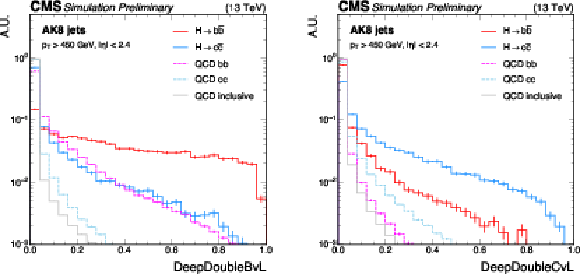
png pdf |
Figure 2:
The normalised distributions of the DeepDoubleBvL (left) and DeepDoubleCvL (right) discriminants on the simulated signal $ \mathrm{X} \rightarrow \mathrm{b} \overline{\mathrm{b}} $ and $ \mathrm{X} \rightarrow \mathrm{c} \overline{\mathrm{c}} $ jets, the bb and cc components of QCD multijet background jets, and inclusive QCD jets, using simulated events in the 2018 data-taking conditions. |
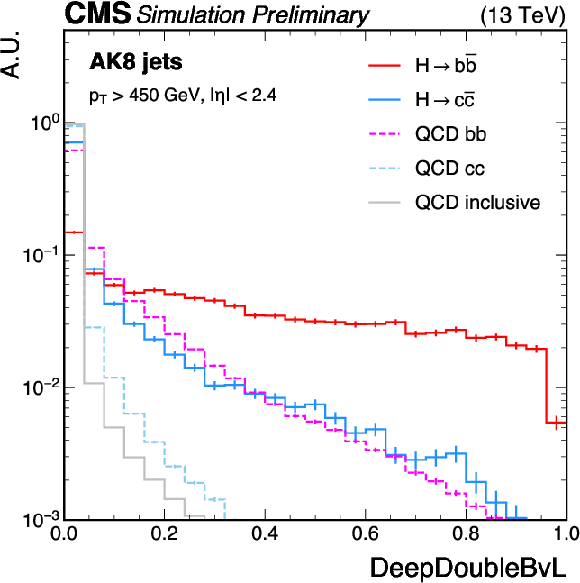
png pdf |
Figure 2-a:
The normalised distributions of the DeepDoubleBvL (left) and DeepDoubleCvL (right) discriminants on the simulated signal $ \mathrm{X} \rightarrow \mathrm{b} \overline{\mathrm{b}} $ and $ \mathrm{X} \rightarrow \mathrm{c} \overline{\mathrm{c}} $ jets, the bb and cc components of QCD multijet background jets, and inclusive QCD jets, using simulated events in the 2018 data-taking conditions. |

png pdf |
Figure 2-b:
The normalised distributions of the DeepDoubleBvL (left) and DeepDoubleCvL (right) discriminants on the simulated signal $ \mathrm{X} \rightarrow \mathrm{b} \overline{\mathrm{b}} $ and $ \mathrm{X} \rightarrow \mathrm{c} \overline{\mathrm{c}} $ jets, the bb and cc components of QCD multijet background jets, and inclusive QCD jets, using simulated events in the 2018 data-taking conditions. |

png pdf |
Figure 3:
The normalised distributions of the DeepAK8-MD bbvsQCD (left) and DeepAK8-MD ccvsQCD (right) discriminants on the simulated signal $ \mathrm{X} \rightarrow \mathrm{b} \overline{\mathrm{b}} $ and $ \mathrm{X} \rightarrow \mathrm{c} \overline{\mathrm{c}} $ jets, the bb and cc components of QCD multijet background jets, and inclusive QCD jets, using simulated events in the 2018 data-taking conditions. |

png pdf |
Figure 3-a:
The normalised distributions of the DeepAK8-MD bbvsQCD (left) and DeepAK8-MD ccvsQCD (right) discriminants on the simulated signal $ \mathrm{X} \rightarrow \mathrm{b} \overline{\mathrm{b}} $ and $ \mathrm{X} \rightarrow \mathrm{c} \overline{\mathrm{c}} $ jets, the bb and cc components of QCD multijet background jets, and inclusive QCD jets, using simulated events in the 2018 data-taking conditions. |
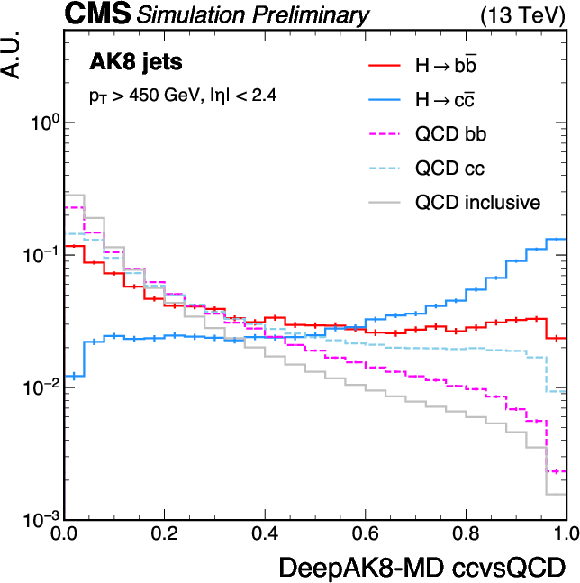
png pdf |
Figure 3-b:
The normalised distributions of the DeepAK8-MD bbvsQCD (left) and DeepAK8-MD ccvsQCD (right) discriminants on the simulated signal $ \mathrm{X} \rightarrow \mathrm{b} \overline{\mathrm{b}} $ and $ \mathrm{X} \rightarrow \mathrm{c} \overline{\mathrm{c}} $ jets, the bb and cc components of QCD multijet background jets, and inclusive QCD jets, using simulated events in the 2018 data-taking conditions. |

png pdf |
Figure 4:
The normalised distributions of the double-b discriminant on the simulated signal $ \mathrm{X} \rightarrow \mathrm{b} \overline{\mathrm{b}} $ and $ \mathrm{X} \rightarrow \mathrm{c} \overline{\mathrm{c}} $ jets, the bb and cc components of QCD multijet background jets, and inclusive QCD jets, using simulated events in the 2018 data-taking conditions. |

png pdf |
Figure 5:
Comparison of the performance of the $ \mathrm{X} \rightarrow \mathrm{b} \overline{\mathrm{b}} $ identification algorithms in terms of receiver operating characteristic (ROC) curves for $ \mathrm{H} \rightarrow \mathrm{b} \overline{\mathrm{b}} $ signal jets versus the inclusive QCD jets as background, using simulated events in the 2018 data-taking conditions. Performance is shown in the 450 $ < p_{\mathrm{T}} < $ 600 GeV (left) and $ p_{\mathrm{T}} > $ 600 GeV (right) regions. Additional selection criteria applied to the jets are displayed on the plots. |

png pdf |
Figure 5-a:
Comparison of the performance of the $ \mathrm{X} \rightarrow \mathrm{b} \overline{\mathrm{b}} $ identification algorithms in terms of receiver operating characteristic (ROC) curves for $ \mathrm{H} \rightarrow \mathrm{b} \overline{\mathrm{b}} $ signal jets versus the inclusive QCD jets as background, using simulated events in the 2018 data-taking conditions. Performance is shown in the 450 $ < p_{\mathrm{T}} < $ 600 GeV (left) and $ p_{\mathrm{T}} > $ 600 GeV (right) regions. Additional selection criteria applied to the jets are displayed on the plots. |
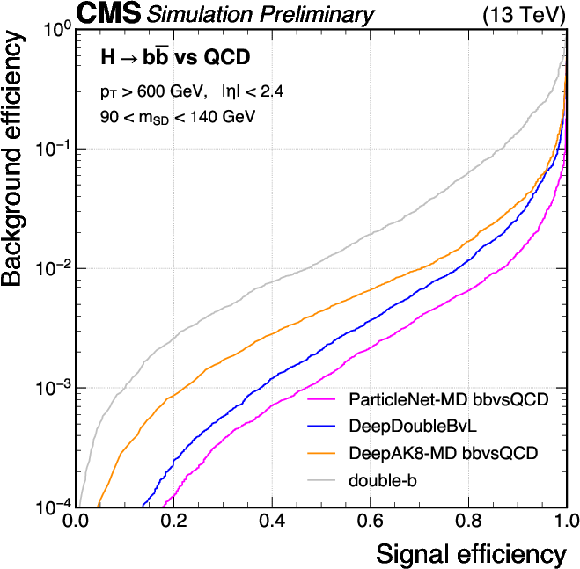
png pdf |
Figure 5-b:
Comparison of the performance of the $ \mathrm{X} \rightarrow \mathrm{b} \overline{\mathrm{b}} $ identification algorithms in terms of receiver operating characteristic (ROC) curves for $ \mathrm{H} \rightarrow \mathrm{b} \overline{\mathrm{b}} $ signal jets versus the inclusive QCD jets as background, using simulated events in the 2018 data-taking conditions. Performance is shown in the 450 $ < p_{\mathrm{T}} < $ 600 GeV (left) and $ p_{\mathrm{T}} > $ 600 GeV (right) regions. Additional selection criteria applied to the jets are displayed on the plots. |

png pdf |
Figure 6:
Comparison of the performance of the $ \mathrm{X} \rightarrow \mathrm{c} \overline{\mathrm{c}} $ identification algorithms in terms of receiver operating characteristic (ROC) curves for $ \mathrm{H} \rightarrow \mathrm{c} \overline{\mathrm{c}} $ signal jets versus the inclusive QCD jets as background, using simulated events in the 2018 data-taking conditions. Performance is shown in the 450 $ < p_{\mathrm{T}} < $ 600 GeV (left) and $ p_{\mathrm{T}} > $ 600 GeV (right) regions. Additional selection criteria applied to the jets are displayed on the plots. |
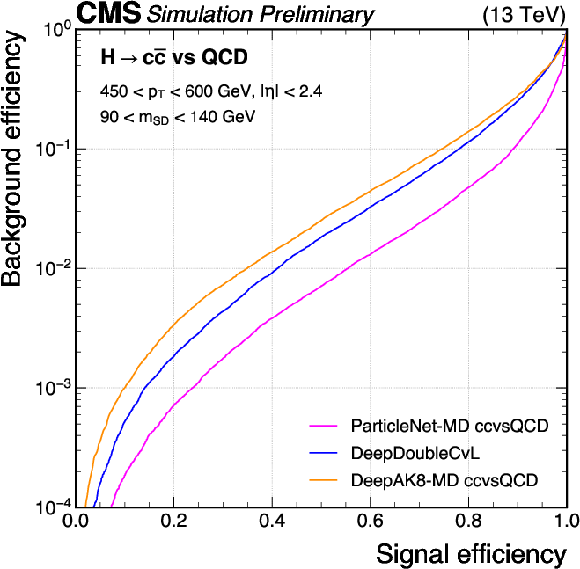
png pdf |
Figure 6-a:
Comparison of the performance of the $ \mathrm{X} \rightarrow \mathrm{c} \overline{\mathrm{c}} $ identification algorithms in terms of receiver operating characteristic (ROC) curves for $ \mathrm{H} \rightarrow \mathrm{c} \overline{\mathrm{c}} $ signal jets versus the inclusive QCD jets as background, using simulated events in the 2018 data-taking conditions. Performance is shown in the 450 $ < p_{\mathrm{T}} < $ 600 GeV (left) and $ p_{\mathrm{T}} > $ 600 GeV (right) regions. Additional selection criteria applied to the jets are displayed on the plots. |

png pdf |
Figure 6-b:
Comparison of the performance of the $ \mathrm{X} \rightarrow \mathrm{c} \overline{\mathrm{c}} $ identification algorithms in terms of receiver operating characteristic (ROC) curves for $ \mathrm{H} \rightarrow \mathrm{c} \overline{\mathrm{c}} $ signal jets versus the inclusive QCD jets as background, using simulated events in the 2018 data-taking conditions. Performance is shown in the 450 $ < p_{\mathrm{T}} < $ 600 GeV (left) and $ p_{\mathrm{T}} > $ 600 GeV (right) regions. Additional selection criteria applied to the jets are displayed on the plots. |

png pdf |
Figure 7:
Comparison of the performance of the $ \mathrm{X} \rightarrow \mathrm{b} \overline{\mathrm{b}} $ identification algorithms in terms of receiver operating characteristic (ROC) curves for $ \mathrm{H} \rightarrow \mathrm{b} \overline{\mathrm{b}} $ signal jets versus the bb component of the QCD jets as background, using simulated events in the 2018 data-taking conditions. Performance is shown in the 450 $ < p_{\mathrm{T}} < $ 600 GeV (left) and $ p_{\mathrm{T}} > $ 600 GeV (right) regions. Additional selection criteria applied to the jets are displayed on the plots. |
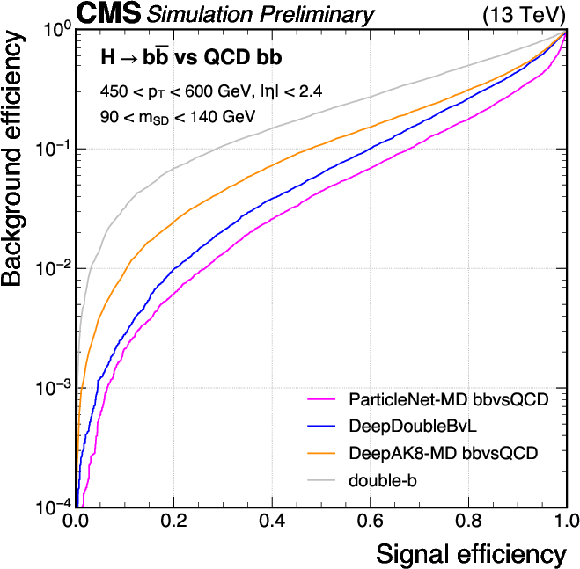
png pdf |
Figure 7-a:
Comparison of the performance of the $ \mathrm{X} \rightarrow \mathrm{b} \overline{\mathrm{b}} $ identification algorithms in terms of receiver operating characteristic (ROC) curves for $ \mathrm{H} \rightarrow \mathrm{b} \overline{\mathrm{b}} $ signal jets versus the bb component of the QCD jets as background, using simulated events in the 2018 data-taking conditions. Performance is shown in the 450 $ < p_{\mathrm{T}} < $ 600 GeV (left) and $ p_{\mathrm{T}} > $ 600 GeV (right) regions. Additional selection criteria applied to the jets are displayed on the plots. |

png pdf |
Figure 7-b:
Comparison of the performance of the $ \mathrm{X} \rightarrow \mathrm{b} \overline{\mathrm{b}} $ identification algorithms in terms of receiver operating characteristic (ROC) curves for $ \mathrm{H} \rightarrow \mathrm{b} \overline{\mathrm{b}} $ signal jets versus the bb component of the QCD jets as background, using simulated events in the 2018 data-taking conditions. Performance is shown in the 450 $ < p_{\mathrm{T}} < $ 600 GeV (left) and $ p_{\mathrm{T}} > $ 600 GeV (right) regions. Additional selection criteria applied to the jets are displayed on the plots. |

png pdf |
Figure 8:
Comparison of the performance of the $ \mathrm{X} \rightarrow \mathrm{c} \overline{\mathrm{c}} $ identification algorithms in terms of receiver operating characteristic (ROC) curves for $ \mathrm{H} \rightarrow \mathrm{c} \overline{\mathrm{c}} $ signal jets versus the cc component of the QCD jets as background, using simulated events in the 2018 data-taking conditions. Performance is shown in the 450 $ < p_{\mathrm{T}} < $ 600 GeV (left) and $ p_{\mathrm{T}} > $ 600 GeV (right) regions. Additional selection criteria applied to the jets are displayed on the plots. |

png pdf |
Figure 8-a:
Comparison of the performance of the $ \mathrm{X} \rightarrow \mathrm{c} \overline{\mathrm{c}} $ identification algorithms in terms of receiver operating characteristic (ROC) curves for $ \mathrm{H} \rightarrow \mathrm{c} \overline{\mathrm{c}} $ signal jets versus the cc component of the QCD jets as background, using simulated events in the 2018 data-taking conditions. Performance is shown in the 450 $ < p_{\mathrm{T}} < $ 600 GeV (left) and $ p_{\mathrm{T}} > $ 600 GeV (right) regions. Additional selection criteria applied to the jets are displayed on the plots. |
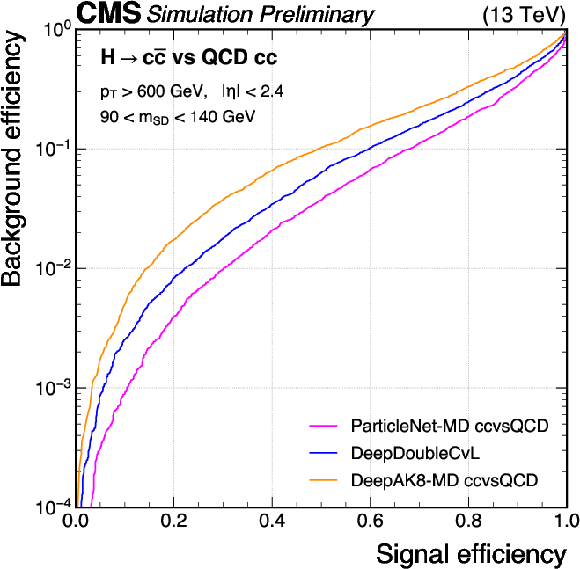
png pdf |
Figure 8-b:
Comparison of the performance of the $ \mathrm{X} \rightarrow \mathrm{c} \overline{\mathrm{c}} $ identification algorithms in terms of receiver operating characteristic (ROC) curves for $ \mathrm{H} \rightarrow \mathrm{c} \overline{\mathrm{c}} $ signal jets versus the cc component of the QCD jets as background, using simulated events in the 2018 data-taking conditions. Performance is shown in the 450 $ < p_{\mathrm{T}} < $ 600 GeV (left) and $ p_{\mathrm{T}} > $ 600 GeV (right) regions. Additional selection criteria applied to the jets are displayed on the plots. |

png pdf |
Figure 9:
The sfBDT selection curves on the 2D plane of the sfBDT score and the transformed tagger discriminant scores, derived for the calibration of the ParticleNet-MD $ \mathrm{X} \rightarrow \mathrm{b} \overline{\mathrm{b}} $ (left) and ParticleNet-MD $ \mathrm{X} \rightarrow \mathrm{c} \overline{\mathrm{c}} $ (right) discriminants, using simulated events in the 2018 data-taking conditions with jet $ p_{\mathrm{T}} $ range of (400, 500) GeV. |
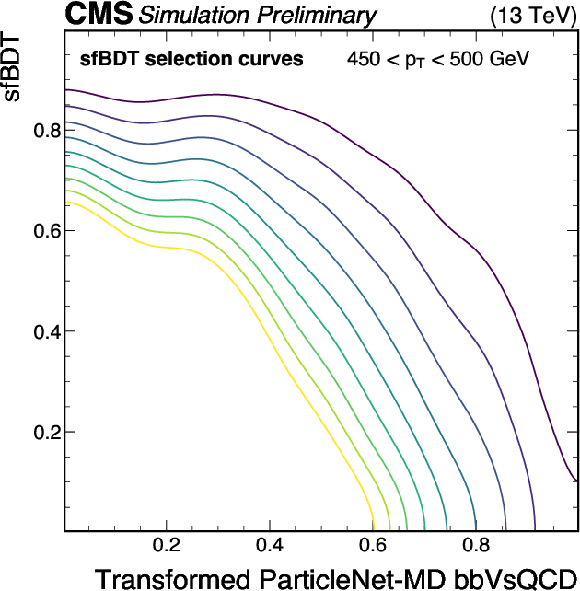
png pdf |
Figure 9-a:
The sfBDT selection curves on the 2D plane of the sfBDT score and the transformed tagger discriminant scores, derived for the calibration of the ParticleNet-MD $ \mathrm{X} \rightarrow \mathrm{b} \overline{\mathrm{b}} $ (left) and ParticleNet-MD $ \mathrm{X} \rightarrow \mathrm{c} \overline{\mathrm{c}} $ (right) discriminants, using simulated events in the 2018 data-taking conditions with jet $ p_{\mathrm{T}} $ range of (400, 500) GeV. |

png pdf |
Figure 9-b:
The sfBDT selection curves on the 2D plane of the sfBDT score and the transformed tagger discriminant scores, derived for the calibration of the ParticleNet-MD $ \mathrm{X} \rightarrow \mathrm{b} \overline{\mathrm{b}} $ (left) and ParticleNet-MD $ \mathrm{X} \rightarrow \mathrm{c} \overline{\mathrm{c}} $ (right) discriminants, using simulated events in the 2018 data-taking conditions with jet $ p_{\mathrm{T}} $ range of (400, 500) GeV. |

png pdf |
Figure 10:
An example of the transformed ParticleNet-MD $ \mathrm{X} \rightarrow \mathrm{b} \overline{\mathrm{b}} $ (left) and $ \mathrm{X} \rightarrow \mathrm{c} \overline{\mathrm{c}} $ (right) distribution in data and simulated events, passing the preselection and the central sfBDT selection in the sfBDT method. The transformed score $ X_0 $ is defined such that a selection of $ X > X_0 $ corresponds to the $ \mathrm{H} \rightarrow \mathrm{b} \overline{\mathrm{b}} $ or $ \mathrm{H} \rightarrow \mathrm{c} \overline{\mathrm{c}} $ signal jet selection efficiency of 1 $ -X_0 $. The working points of high purity, medium purity, and low purity for the left (right) plot indicate a selection on $ X > $ 0.6, 0.4, 0.2 (0.85, 0.7, 0.5). The distribution is based on data and simulated events in the 2018 data-taking conditions, in the jet $ p_{\mathrm{T}} $ range of (400, 500) GeV. |

png pdf |
Figure 10-a:
An example of the transformed ParticleNet-MD $ \mathrm{X} \rightarrow \mathrm{b} \overline{\mathrm{b}} $ (left) and $ \mathrm{X} \rightarrow \mathrm{c} \overline{\mathrm{c}} $ (right) distribution in data and simulated events, passing the preselection and the central sfBDT selection in the sfBDT method. The transformed score $ X_0 $ is defined such that a selection of $ X > X_0 $ corresponds to the $ \mathrm{H} \rightarrow \mathrm{b} \overline{\mathrm{b}} $ or $ \mathrm{H} \rightarrow \mathrm{c} \overline{\mathrm{c}} $ signal jet selection efficiency of 1 $ -X_0 $. The working points of high purity, medium purity, and low purity for the left (right) plot indicate a selection on $ X > $ 0.6, 0.4, 0.2 (0.85, 0.7, 0.5). The distribution is based on data and simulated events in the 2018 data-taking conditions, in the jet $ p_{\mathrm{T}} $ range of (400, 500) GeV. |

png pdf |
Figure 10-b:
An example of the transformed ParticleNet-MD $ \mathrm{X} \rightarrow \mathrm{b} \overline{\mathrm{b}} $ (left) and $ \mathrm{X} \rightarrow \mathrm{c} \overline{\mathrm{c}} $ (right) distribution in data and simulated events, passing the preselection and the central sfBDT selection in the sfBDT method. The transformed score $ X_0 $ is defined such that a selection of $ X > X_0 $ corresponds to the $ \mathrm{H} \rightarrow \mathrm{b} \overline{\mathrm{b}} $ or $ \mathrm{H} \rightarrow \mathrm{c} \overline{\mathrm{c}} $ signal jet selection efficiency of 1 $ -X_0 $. The working points of high purity, medium purity, and low purity for the left (right) plot indicate a selection on $ X > $ 0.6, 0.4, 0.2 (0.85, 0.7, 0.5). The distribution is based on data and simulated events in the 2018 data-taking conditions, in the jet $ p_{\mathrm{T}} $ range of (400, 500) GeV. |

png pdf |
Figure 11:
An example of the transformed DeepDoubleX $ \mathrm{X} \rightarrow \mathrm{b} \overline{\mathrm{b}} $ (left) and $ \mathrm{X} \rightarrow \mathrm{c} \overline{\mathrm{c}} $ (right) distribution in data and simulated events, passing the preselection and the central sfBDT selection in the sfBDT method. The transformed score $ X_0 $ is defined such that a selection of $ X > X_0 $ corresponds to the $ \mathrm{H} \rightarrow \mathrm{b} \overline{\mathrm{b}} $ or $ \mathrm{H} \rightarrow \mathrm{c} \overline{\mathrm{c}} $ signal jet selection efficiency of 1 $ -X_0 $. The working points of high purity, medium purity, and low purity for the left (right) plot indicate a selection on $ X > $ 0.6, 0.4, 0.2 (0.85, 0.7, 0.5). The distribution is based on data and simulated events in the 2018 data-taking conditions, in the jet $ p_{\mathrm{T}} $ range of (400, 500) GeV. |

png pdf |
Figure 11-a:
An example of the transformed DeepDoubleX $ \mathrm{X} \rightarrow \mathrm{b} \overline{\mathrm{b}} $ (left) and $ \mathrm{X} \rightarrow \mathrm{c} \overline{\mathrm{c}} $ (right) distribution in data and simulated events, passing the preselection and the central sfBDT selection in the sfBDT method. The transformed score $ X_0 $ is defined such that a selection of $ X > X_0 $ corresponds to the $ \mathrm{H} \rightarrow \mathrm{b} \overline{\mathrm{b}} $ or $ \mathrm{H} \rightarrow \mathrm{c} \overline{\mathrm{c}} $ signal jet selection efficiency of 1 $ -X_0 $. The working points of high purity, medium purity, and low purity for the left (right) plot indicate a selection on $ X > $ 0.6, 0.4, 0.2 (0.85, 0.7, 0.5). The distribution is based on data and simulated events in the 2018 data-taking conditions, in the jet $ p_{\mathrm{T}} $ range of (400, 500) GeV. |

png pdf |
Figure 11-b:
An example of the transformed DeepDoubleX $ \mathrm{X} \rightarrow \mathrm{b} \overline{\mathrm{b}} $ (left) and $ \mathrm{X} \rightarrow \mathrm{c} \overline{\mathrm{c}} $ (right) distribution in data and simulated events, passing the preselection and the central sfBDT selection in the sfBDT method. The transformed score $ X_0 $ is defined such that a selection of $ X > X_0 $ corresponds to the $ \mathrm{H} \rightarrow \mathrm{b} \overline{\mathrm{b}} $ or $ \mathrm{H} \rightarrow \mathrm{c} \overline{\mathrm{c}} $ signal jet selection efficiency of 1 $ -X_0 $. The working points of high purity, medium purity, and low purity for the left (right) plot indicate a selection on $ X > $ 0.6, 0.4, 0.2 (0.85, 0.7, 0.5). The distribution is based on data and simulated events in the 2018 data-taking conditions, in the jet $ p_{\mathrm{T}} $ range of (400, 500) GeV. |

png pdf |
Figure 12:
An example of the transformed DeepAK8-MD $ \mathrm{X} \rightarrow \mathrm{b} \overline{\mathrm{b}} $ (left) and $ \mathrm{X} \rightarrow \mathrm{c} \overline{\mathrm{c}} $ (right) distribution in data and simulated events, passing the preselection and the central sfBDT selection in the sfBDT method. The transformed score $ X_0 $ is defined such that a selection of $ X > X_0 $ corresponds to the $ \mathrm{H} \rightarrow \mathrm{b} \overline{\mathrm{b}} $ or $ \mathrm{H} \rightarrow \mathrm{c} \overline{\mathrm{c}} $ signal jet selection efficiency of 1 $ -X_0 $. The working points of high purity, medium purity, and low purity for the left (right) plot indicate a selection on $ X > $ 0.6, 0.4, 0.2 (0.85, 0.7, 0.5). The distribution is based on data and simulated events in the 2018 data-taking conditions, in the jet $ p_{\mathrm{T}} $ range of (400, 500) GeV. |

png pdf |
Figure 12-a:
An example of the transformed DeepAK8-MD $ \mathrm{X} \rightarrow \mathrm{b} \overline{\mathrm{b}} $ (left) and $ \mathrm{X} \rightarrow \mathrm{c} \overline{\mathrm{c}} $ (right) distribution in data and simulated events, passing the preselection and the central sfBDT selection in the sfBDT method. The transformed score $ X_0 $ is defined such that a selection of $ X > X_0 $ corresponds to the $ \mathrm{H} \rightarrow \mathrm{b} \overline{\mathrm{b}} $ or $ \mathrm{H} \rightarrow \mathrm{c} \overline{\mathrm{c}} $ signal jet selection efficiency of 1 $ -X_0 $. The working points of high purity, medium purity, and low purity for the left (right) plot indicate a selection on $ X > $ 0.6, 0.4, 0.2 (0.85, 0.7, 0.5). The distribution is based on data and simulated events in the 2018 data-taking conditions, in the jet $ p_{\mathrm{T}} $ range of (400, 500) GeV. |

png pdf |
Figure 12-b:
An example of the transformed DeepAK8-MD $ \mathrm{X} \rightarrow \mathrm{b} \overline{\mathrm{b}} $ (left) and $ \mathrm{X} \rightarrow \mathrm{c} \overline{\mathrm{c}} $ (right) distribution in data and simulated events, passing the preselection and the central sfBDT selection in the sfBDT method. The transformed score $ X_0 $ is defined such that a selection of $ X > X_0 $ corresponds to the $ \mathrm{H} \rightarrow \mathrm{b} \overline{\mathrm{b}} $ or $ \mathrm{H} \rightarrow \mathrm{c} \overline{\mathrm{c}} $ signal jet selection efficiency of 1 $ -X_0 $. The working points of high purity, medium purity, and low purity for the left (right) plot indicate a selection on $ X > $ 0.6, 0.4, 0.2 (0.85, 0.7, 0.5). The distribution is based on data and simulated events in the 2018 data-taking conditions, in the jet $ p_{\mathrm{T}} $ range of (400, 500) GeV. |

png pdf |
Figure 13:
An example of the transformed double-b distribution in data and simulated events, passing the preselection and the central sfBDT selection in the sfBDT method. The transformed score $ X_0 $ is defined such that a selection of $ X > X_0 $ corresponds to the $ \mathrm{H} \rightarrow \mathrm{b} \overline{\mathrm{b}} $ signal jet selection efficiency of 1 $ -X_0 $. The working points of high purity, medium purity, and low purity for the plot indicate a selection on $ X > 0.6,\,0.4,\, $ 0.2. The distribution is based on data and simulated events in the 2018 data-taking conditions, in the jet $ p_{\mathrm{T}} $ range of (400, 500) GeV. |
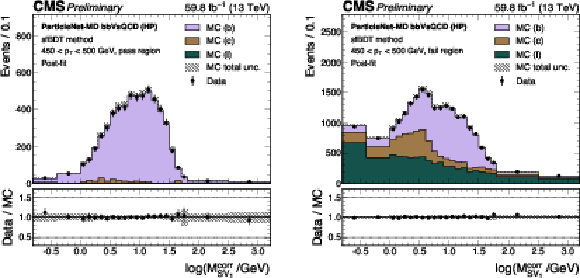
png pdf |
Figure 14:
The post-fit histograms in the sfBDT method for passing (left) and failing (right) the tagger selection, in the derivation of the scale factor of the ParticleNet-MD $ \mathrm{X} \rightarrow \mathrm{b} \overline{\mathrm{b}} $ discriminant at the high purity working point. This example is based on data and simulated events in the 2018 data-taking conditions, in the jet $ p_{\mathrm{T}} $ range of (400, 500) GeV. |

png pdf |
Figure 14-a:
The post-fit histograms in the sfBDT method for passing (left) and failing (right) the tagger selection, in the derivation of the scale factor of the ParticleNet-MD $ \mathrm{X} \rightarrow \mathrm{b} \overline{\mathrm{b}} $ discriminant at the high purity working point. This example is based on data and simulated events in the 2018 data-taking conditions, in the jet $ p_{\mathrm{T}} $ range of (400, 500) GeV. |

png pdf |
Figure 14-b:
The post-fit histograms in the sfBDT method for passing (left) and failing (right) the tagger selection, in the derivation of the scale factor of the ParticleNet-MD $ \mathrm{X} \rightarrow \mathrm{b} \overline{\mathrm{b}} $ discriminant at the high purity working point. This example is based on data and simulated events in the 2018 data-taking conditions, in the jet $ p_{\mathrm{T}} $ range of (400, 500) GeV. |

png pdf |
Figure 15:
The post-fit histograms in the sfBDT method for passing (left) and failing (right) the tagger selection, in the derivation of the scale factor of the ParticleNet-MD $ \mathrm{X} \rightarrow \mathrm{c} \overline{\mathrm{c}} $ discriminant at the high purity working point. This example is based on data and simulated events in the 2018 data-taking conditions, in the jet $ p_{\mathrm{T}} $ range of (400, 500) GeV. |

png pdf |
Figure 15-a:
The post-fit histograms in the sfBDT method for passing (left) and failing (right) the tagger selection, in the derivation of the scale factor of the ParticleNet-MD $ \mathrm{X} \rightarrow \mathrm{c} \overline{\mathrm{c}} $ discriminant at the high purity working point. This example is based on data and simulated events in the 2018 data-taking conditions, in the jet $ p_{\mathrm{T}} $ range of (400, 500) GeV. |

png pdf |
Figure 15-b:
The post-fit histograms in the sfBDT method for passing (left) and failing (right) the tagger selection, in the derivation of the scale factor of the ParticleNet-MD $ \mathrm{X} \rightarrow \mathrm{c} \overline{\mathrm{c}} $ discriminant at the high purity working point. This example is based on data and simulated events in the 2018 data-taking conditions, in the jet $ p_{\mathrm{T}} $ range of (400, 500) GeV. |

png pdf |
Figure 16:
An example of the transformed ParticleNet-MD $ \mathrm{X} \rightarrow \mathrm{b} \overline{\mathrm{b}} $ (left) and $ \mathrm{X} \rightarrow \mathrm{c} \overline{\mathrm{c}} $ (right) distribution in data and simulated events, passing the preselection of the $ \mu $-tagged method. The transformed score $ X_0 $ is defined such that a selection of $ X > X_0 $ corresponds to the $ \mathrm{H} \rightarrow \mathrm{b} \overline{\mathrm{b}} $ or $ \mathrm{H} \rightarrow \mathrm{c} \overline{\mathrm{c}} $ signal jet selection efficiency of 1 $ -X_0 $. The working points of high purity, medium purity, and low purity for the left (right) plot indicate a selection on $ X > $ 0.6, 0.4, 0.2 (0.85, 0.7, 0.5). The distribution is based on data and simulated events in the 2018 data-taking conditions, in the jet $ p_{\mathrm{T}} $ range of (400, 500) GeV. |
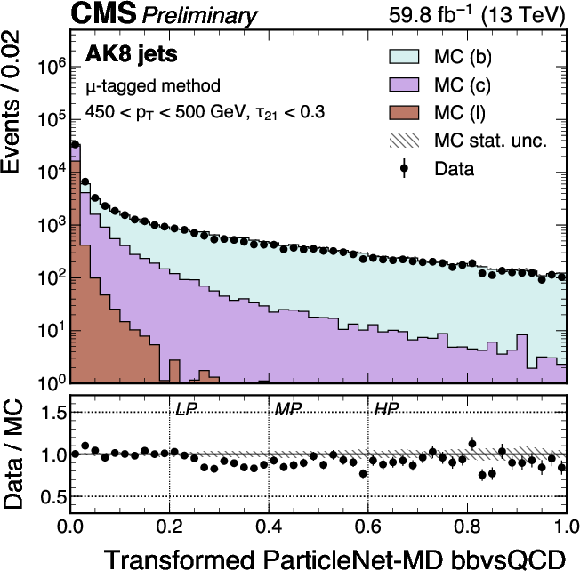
png pdf |
Figure 16-a:
An example of the transformed ParticleNet-MD $ \mathrm{X} \rightarrow \mathrm{b} \overline{\mathrm{b}} $ (left) and $ \mathrm{X} \rightarrow \mathrm{c} \overline{\mathrm{c}} $ (right) distribution in data and simulated events, passing the preselection of the $ \mu $-tagged method. The transformed score $ X_0 $ is defined such that a selection of $ X > X_0 $ corresponds to the $ \mathrm{H} \rightarrow \mathrm{b} \overline{\mathrm{b}} $ or $ \mathrm{H} \rightarrow \mathrm{c} \overline{\mathrm{c}} $ signal jet selection efficiency of 1 $ -X_0 $. The working points of high purity, medium purity, and low purity for the left (right) plot indicate a selection on $ X > $ 0.6, 0.4, 0.2 (0.85, 0.7, 0.5). The distribution is based on data and simulated events in the 2018 data-taking conditions, in the jet $ p_{\mathrm{T}} $ range of (400, 500) GeV. |
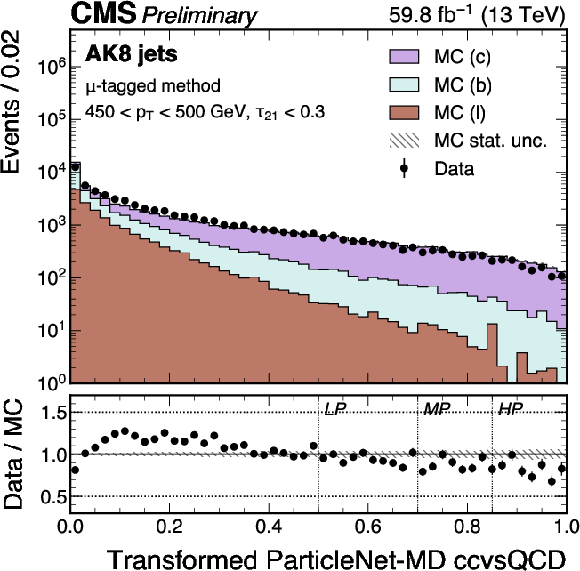
png pdf |
Figure 16-b:
An example of the transformed ParticleNet-MD $ \mathrm{X} \rightarrow \mathrm{b} \overline{\mathrm{b}} $ (left) and $ \mathrm{X} \rightarrow \mathrm{c} \overline{\mathrm{c}} $ (right) distribution in data and simulated events, passing the preselection of the $ \mu $-tagged method. The transformed score $ X_0 $ is defined such that a selection of $ X > X_0 $ corresponds to the $ \mathrm{H} \rightarrow \mathrm{b} \overline{\mathrm{b}} $ or $ \mathrm{H} \rightarrow \mathrm{c} \overline{\mathrm{c}} $ signal jet selection efficiency of 1 $ -X_0 $. The working points of high purity, medium purity, and low purity for the left (right) plot indicate a selection on $ X > $ 0.6, 0.4, 0.2 (0.85, 0.7, 0.5). The distribution is based on data and simulated events in the 2018 data-taking conditions, in the jet $ p_{\mathrm{T}} $ range of (400, 500) GeV. |

png pdf |
Figure 17:
An example of the transformed DeepDoubleX $ \mathrm{X} \rightarrow \mathrm{b} \overline{\mathrm{b}} $ (left) and $ \mathrm{X} \rightarrow \mathrm{c} \overline{\mathrm{c}} $ (right) distribution in data and simulated events, passing the preselection of the $ \mu $-tagged method. The transformed score $ X_0 $ is defined such that a selection of $ X > X_0 $ corresponds to the $ \mathrm{H} \rightarrow \mathrm{b} \overline{\mathrm{b}} $ or $ \mathrm{H} \rightarrow \mathrm{c} \overline{\mathrm{c}} $ signal jet selection efficiency of 1 $ -X_0 $. The working points of high purity, medium purity, and low purity for the left (right) plot indicate a selection on $ X > $ 0.6, 0.4, 0.2 (0.85, 0.7, 0.5). The distribution is based on data and simulated events in the 2018 data-taking conditions, in the jet $ p_{\mathrm{T}} $ range of (400, 500) GeV. |

png pdf |
Figure 17-a:
An example of the transformed DeepDoubleX $ \mathrm{X} \rightarrow \mathrm{b} \overline{\mathrm{b}} $ (left) and $ \mathrm{X} \rightarrow \mathrm{c} \overline{\mathrm{c}} $ (right) distribution in data and simulated events, passing the preselection of the $ \mu $-tagged method. The transformed score $ X_0 $ is defined such that a selection of $ X > X_0 $ corresponds to the $ \mathrm{H} \rightarrow \mathrm{b} \overline{\mathrm{b}} $ or $ \mathrm{H} \rightarrow \mathrm{c} \overline{\mathrm{c}} $ signal jet selection efficiency of 1 $ -X_0 $. The working points of high purity, medium purity, and low purity for the left (right) plot indicate a selection on $ X > $ 0.6, 0.4, 0.2 (0.85, 0.7, 0.5). The distribution is based on data and simulated events in the 2018 data-taking conditions, in the jet $ p_{\mathrm{T}} $ range of (400, 500) GeV. |

png pdf |
Figure 17-b:
An example of the transformed DeepDoubleX $ \mathrm{X} \rightarrow \mathrm{b} \overline{\mathrm{b}} $ (left) and $ \mathrm{X} \rightarrow \mathrm{c} \overline{\mathrm{c}} $ (right) distribution in data and simulated events, passing the preselection of the $ \mu $-tagged method. The transformed score $ X_0 $ is defined such that a selection of $ X > X_0 $ corresponds to the $ \mathrm{H} \rightarrow \mathrm{b} \overline{\mathrm{b}} $ or $ \mathrm{H} \rightarrow \mathrm{c} \overline{\mathrm{c}} $ signal jet selection efficiency of 1 $ -X_0 $. The working points of high purity, medium purity, and low purity for the left (right) plot indicate a selection on $ X > $ 0.6, 0.4, 0.2 (0.85, 0.7, 0.5). The distribution is based on data and simulated events in the 2018 data-taking conditions, in the jet $ p_{\mathrm{T}} $ range of (400, 500) GeV. |
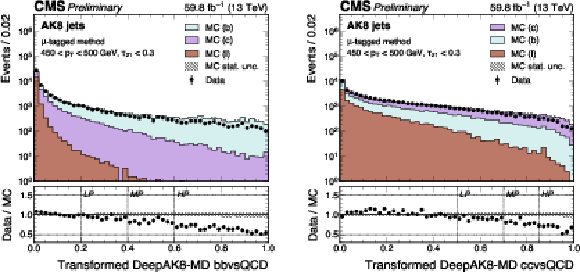
png pdf |
Figure 18:
An example of the transformed DeepAK8-MD $ \mathrm{X} \rightarrow \mathrm{b} \overline{\mathrm{b}} $ (left) and $ \mathrm{X} \rightarrow \mathrm{c} \overline{\mathrm{c}} $ (right) distribution in data and simulated events, passing the preselection of the $ \mu $-tagged method. The transformed score $ X_0 $ is defined such that a selection of $ X > X_0 $ corresponds to the $ \mathrm{H} \rightarrow \mathrm{b} \overline{\mathrm{b}} $ or $ \mathrm{H} \rightarrow \mathrm{c} \overline{\mathrm{c}} $ signal jet selection efficiency of 1 $ -X_0 $. The working points of high purity, medium purity, and low purity for the left (right) plot indicate a selection on $ X > $ 0.6, 0.4, 0.2 (0.85, 0.7, 0.5). The distribution is based on data and simulated events in the 2018 data-taking conditions, in the jet $ p_{\mathrm{T}} $ range of (400, 500) GeV. |

png pdf |
Figure 18-a:
An example of the transformed DeepAK8-MD $ \mathrm{X} \rightarrow \mathrm{b} \overline{\mathrm{b}} $ (left) and $ \mathrm{X} \rightarrow \mathrm{c} \overline{\mathrm{c}} $ (right) distribution in data and simulated events, passing the preselection of the $ \mu $-tagged method. The transformed score $ X_0 $ is defined such that a selection of $ X > X_0 $ corresponds to the $ \mathrm{H} \rightarrow \mathrm{b} \overline{\mathrm{b}} $ or $ \mathrm{H} \rightarrow \mathrm{c} \overline{\mathrm{c}} $ signal jet selection efficiency of 1 $ -X_0 $. The working points of high purity, medium purity, and low purity for the left (right) plot indicate a selection on $ X > $ 0.6, 0.4, 0.2 (0.85, 0.7, 0.5). The distribution is based on data and simulated events in the 2018 data-taking conditions, in the jet $ p_{\mathrm{T}} $ range of (400, 500) GeV. |

png pdf |
Figure 18-b:
An example of the transformed DeepAK8-MD $ \mathrm{X} \rightarrow \mathrm{b} \overline{\mathrm{b}} $ (left) and $ \mathrm{X} \rightarrow \mathrm{c} \overline{\mathrm{c}} $ (right) distribution in data and simulated events, passing the preselection of the $ \mu $-tagged method. The transformed score $ X_0 $ is defined such that a selection of $ X > X_0 $ corresponds to the $ \mathrm{H} \rightarrow \mathrm{b} \overline{\mathrm{b}} $ or $ \mathrm{H} \rightarrow \mathrm{c} \overline{\mathrm{c}} $ signal jet selection efficiency of 1 $ -X_0 $. The working points of high purity, medium purity, and low purity for the left (right) plot indicate a selection on $ X > $ 0.6, 0.4, 0.2 (0.85, 0.7, 0.5). The distribution is based on data and simulated events in the 2018 data-taking conditions, in the jet $ p_{\mathrm{T}} $ range of (400, 500) GeV. |

png pdf |
Figure 19:
An example of the transformed double-b distribution in data and simulated events, passing the preselection of the $ \mu $-tagged method. The transformed score $ X_0 $ is defined such that a selection of $ X > X_0 $ corresponds to the $ \mathrm{H} \rightarrow \mathrm{b} \overline{\mathrm{b}} $ signal jet selection efficiency of 1 $ -X_0 $. The working points of high purity, medium purity, and low purity for the plot indicate a selection on $ X > 0.6,\,0.4,\, $ 0.2. The distribution is based on data and simulated events in the 2018 data-taking conditions, in the jet $ p_{\mathrm{T}} $ range of (400, 500) GeV. |

png pdf |
Figure 20:
The post-fit histograms in the $ \mu $-tagged method for passing (left) and failing (right) the tagger selection, in the derivation of the scale factor of the ParticleNet-MD $ \mathrm{X} \rightarrow \mathrm{b} \overline{\mathrm{b}} $ discriminant at the high purity working point. This example is based on data and simulated events in the 2018 data-taking conditions, in the jet $ p_{\mathrm{T}} $ range of (400, 500) GeV. |

png pdf |
Figure 20-a:
The post-fit histograms in the $ \mu $-tagged method for passing (left) and failing (right) the tagger selection, in the derivation of the scale factor of the ParticleNet-MD $ \mathrm{X} \rightarrow \mathrm{b} \overline{\mathrm{b}} $ discriminant at the high purity working point. This example is based on data and simulated events in the 2018 data-taking conditions, in the jet $ p_{\mathrm{T}} $ range of (400, 500) GeV. |

png pdf |
Figure 20-b:
The post-fit histograms in the $ \mu $-tagged method for passing (left) and failing (right) the tagger selection, in the derivation of the scale factor of the ParticleNet-MD $ \mathrm{X} \rightarrow \mathrm{b} \overline{\mathrm{b}} $ discriminant at the high purity working point. This example is based on data and simulated events in the 2018 data-taking conditions, in the jet $ p_{\mathrm{T}} $ range of (400, 500) GeV. |

png pdf |
Figure 21:
The post-fit histograms in the $ \mu $-tagged method for passing (left) and failing (right) the tagger selection, in the derivation of the scale factor of the ParticleNet-MD $ \mathrm{X} \rightarrow \mathrm{c} \overline{\mathrm{c}} $ discriminant at the high purity working point. This example is based on data and simulated events in the 2018 data-taking conditions, in the jet $ p_{\mathrm{T}} $ range of (400, 500) GeV. |

png pdf |
Figure 21-a:
The post-fit histograms in the $ \mu $-tagged method for passing (left) and failing (right) the tagger selection, in the derivation of the scale factor of the ParticleNet-MD $ \mathrm{X} \rightarrow \mathrm{c} \overline{\mathrm{c}} $ discriminant at the high purity working point. This example is based on data and simulated events in the 2018 data-taking conditions, in the jet $ p_{\mathrm{T}} $ range of (400, 500) GeV. |
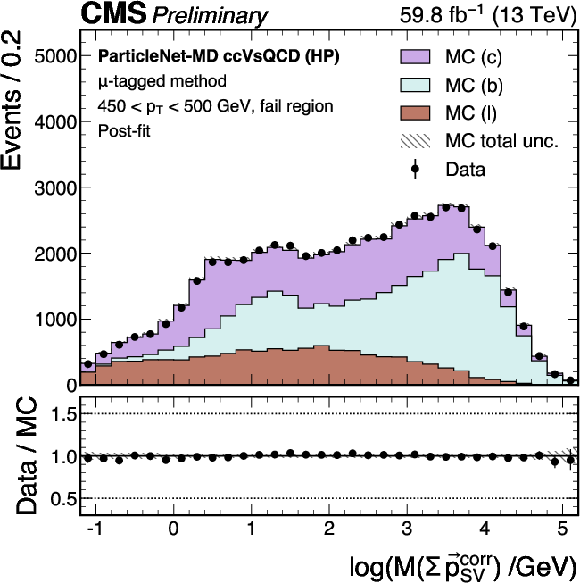
png pdf |
Figure 21-b:
The post-fit histograms in the $ \mu $-tagged method for passing (left) and failing (right) the tagger selection, in the derivation of the scale factor of the ParticleNet-MD $ \mathrm{X} \rightarrow \mathrm{c} \overline{\mathrm{c}} $ discriminant at the high purity working point. This example is based on data and simulated events in the 2018 data-taking conditions, in the jet $ p_{\mathrm{T}} $ range of (400, 500) GeV. |

png pdf |
Figure 22:
The post-fit histograms in the boosted Z method for passing (left) and failing (right) the tagger selection, in the derivation of the scale factor of the ParticleNet-MD $ \mathrm{X} \rightarrow \mathrm{b} \overline{\mathrm{b}} $ discriminant at the high purity working point. This example is based on data and simulated events in the 2018 data-taking conditions, in the jet $ p_{\mathrm{T}} $ range of (400, 500) GeV. The lower panels show the pulls defined as (observed events $-$ expected events) $ /\sqrt{\smash[b]{\sigma_{\text{obs}}^{2} + \sigma_{\text{exp}}^{2}}} $, where $ \sigma_{\text{obs}} $ and $ \sigma_{\text{exp}} $ are the total uncertainties in the observation and the background estimation, respectively. |
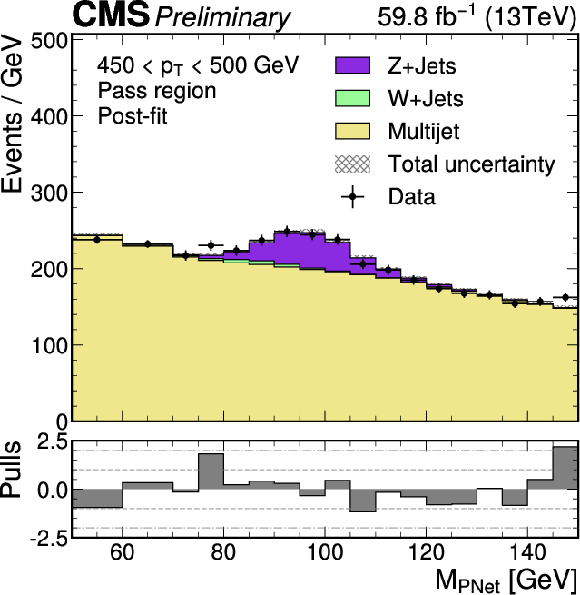
png pdf |
Figure 22-a:
The post-fit histograms in the boosted Z method for passing (left) and failing (right) the tagger selection, in the derivation of the scale factor of the ParticleNet-MD $ \mathrm{X} \rightarrow \mathrm{b} \overline{\mathrm{b}} $ discriminant at the high purity working point. This example is based on data and simulated events in the 2018 data-taking conditions, in the jet $ p_{\mathrm{T}} $ range of (400, 500) GeV. The lower panels show the pulls defined as (observed events $-$ expected events) $ /\sqrt{\smash[b]{\sigma_{\text{obs}}^{2} + \sigma_{\text{exp}}^{2}}} $, where $ \sigma_{\text{obs}} $ and $ \sigma_{\text{exp}} $ are the total uncertainties in the observation and the background estimation, respectively. |

png pdf |
Figure 22-b:
The post-fit histograms in the boosted Z method for passing (left) and failing (right) the tagger selection, in the derivation of the scale factor of the ParticleNet-MD $ \mathrm{X} \rightarrow \mathrm{b} \overline{\mathrm{b}} $ discriminant at the high purity working point. This example is based on data and simulated events in the 2018 data-taking conditions, in the jet $ p_{\mathrm{T}} $ range of (400, 500) GeV. The lower panels show the pulls defined as (observed events $-$ expected events) $ /\sqrt{\smash[b]{\sigma_{\text{obs}}^{2} + \sigma_{\text{exp}}^{2}}} $, where $ \sigma_{\text{obs}} $ and $ \sigma_{\text{exp}} $ are the total uncertainties in the observation and the background estimation, respectively. |

png pdf |
Figure 23:
The ROC curve of the ParticleNet-MD $ \mathrm{X} \rightarrow \mathrm{b} \overline{\mathrm{b}} $ discriminant obtained using simulation (blue) with the three working points pointed out in simulation (filled circles) and in data (hollow circles), under the 2018 data-taking conditions with $ p_{\mathrm{T}} > $ 450 GeV. |

png pdf |
Figure 24:
The measured scale factors of the ParticleNet-MD $ \mathrm{X} \rightarrow \mathrm{b} \overline{\mathrm{b}} $ discriminant in the high purity (left), medium purity (middle), and low purity (right) working points. Three methods are presented in the measurements: the sfBDT method, the $ \mu $-tagged method, and the boosted Z method. The combined measurements from available methods are also shown. |
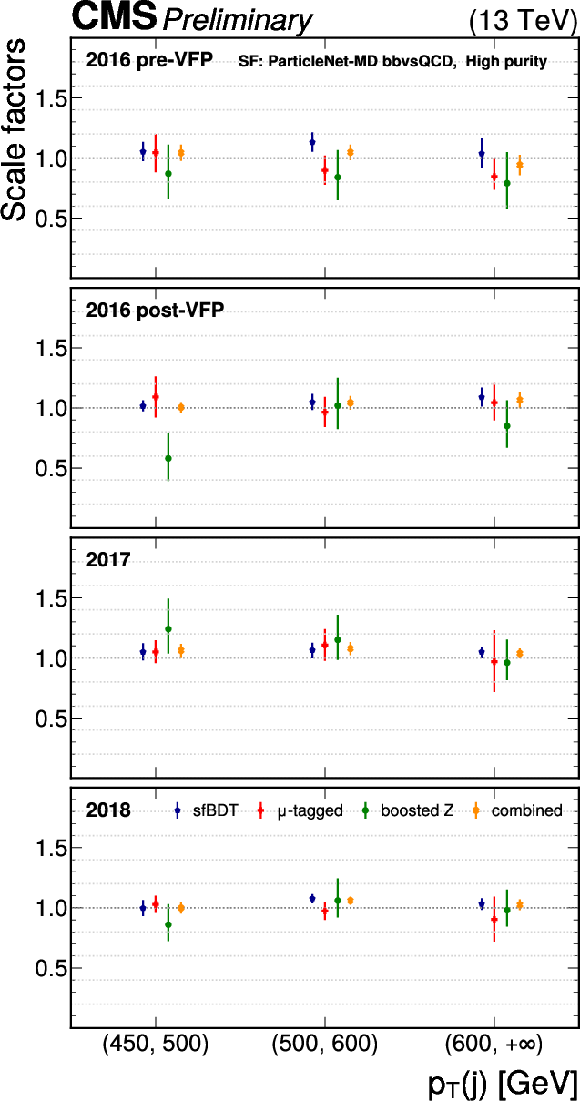
png pdf |
Figure 24-a:
The measured scale factors of the ParticleNet-MD $ \mathrm{X} \rightarrow \mathrm{b} \overline{\mathrm{b}} $ discriminant in the high purity (left), medium purity (middle), and low purity (right) working points. Three methods are presented in the measurements: the sfBDT method, the $ \mu $-tagged method, and the boosted Z method. The combined measurements from available methods are also shown. |
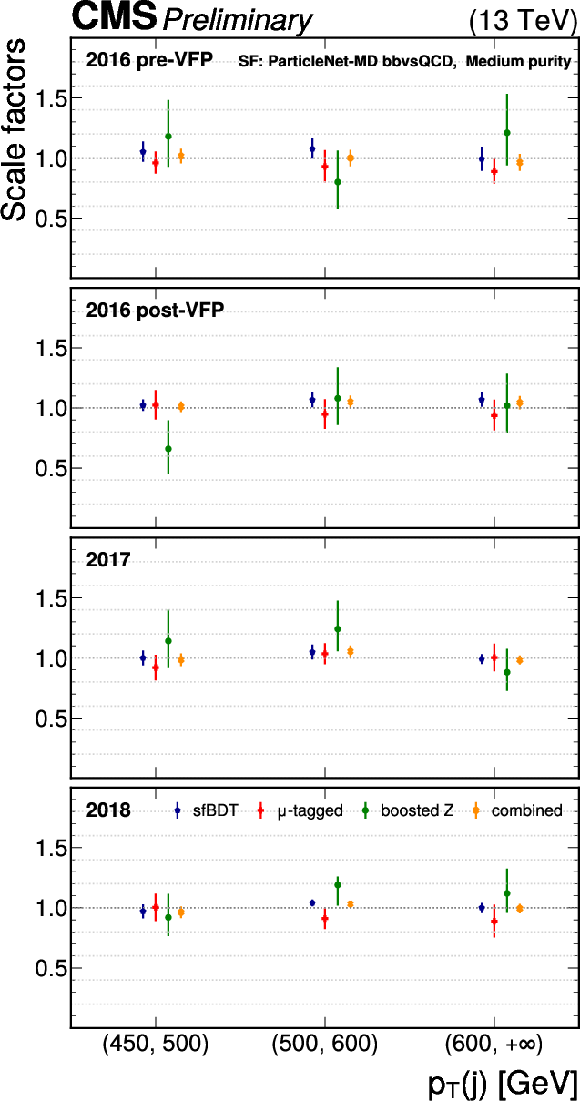
png pdf |
Figure 24-b:
The measured scale factors of the ParticleNet-MD $ \mathrm{X} \rightarrow \mathrm{b} \overline{\mathrm{b}} $ discriminant in the high purity (left), medium purity (middle), and low purity (right) working points. Three methods are presented in the measurements: the sfBDT method, the $ \mu $-tagged method, and the boosted Z method. The combined measurements from available methods are also shown. |

png pdf |
Figure 24-c:
The measured scale factors of the ParticleNet-MD $ \mathrm{X} \rightarrow \mathrm{b} \overline{\mathrm{b}} $ discriminant in the high purity (left), medium purity (middle), and low purity (right) working points. Three methods are presented in the measurements: the sfBDT method, the $ \mu $-tagged method, and the boosted Z method. The combined measurements from available methods are also shown. |
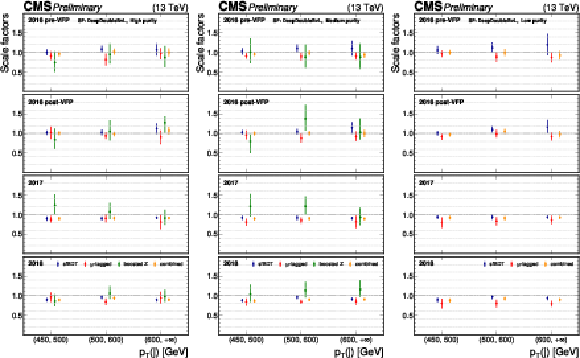
png pdf |
Figure 25:
The measured scale factors of the DeepDoubleX $ \mathrm{X} \rightarrow \mathrm{b} \overline{\mathrm{b}} $ discriminant in the high purity (left), medium purity (middle), and low purity (right) working points. Three methods are presented in the measurements: the sfBDT method, the $ \mu $-tagged method, and the boosted Z method. The combined measurements from available methods are also shown. |

png pdf |
Figure 25-a:
The measured scale factors of the DeepDoubleX $ \mathrm{X} \rightarrow \mathrm{b} \overline{\mathrm{b}} $ discriminant in the high purity (left), medium purity (middle), and low purity (right) working points. Three methods are presented in the measurements: the sfBDT method, the $ \mu $-tagged method, and the boosted Z method. The combined measurements from available methods are also shown. |

png pdf |
Figure 25-b:
The measured scale factors of the DeepDoubleX $ \mathrm{X} \rightarrow \mathrm{b} \overline{\mathrm{b}} $ discriminant in the high purity (left), medium purity (middle), and low purity (right) working points. Three methods are presented in the measurements: the sfBDT method, the $ \mu $-tagged method, and the boosted Z method. The combined measurements from available methods are also shown. |

png pdf |
Figure 25-c:
The measured scale factors of the DeepDoubleX $ \mathrm{X} \rightarrow \mathrm{b} \overline{\mathrm{b}} $ discriminant in the high purity (left), medium purity (middle), and low purity (right) working points. Three methods are presented in the measurements: the sfBDT method, the $ \mu $-tagged method, and the boosted Z method. The combined measurements from available methods are also shown. |
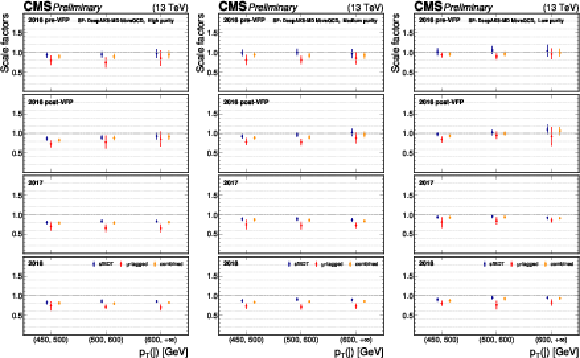
png pdf |
Figure 26:
The measured scale factors of the DeepAK8-MD $ \mathrm{X} \rightarrow \mathrm{b} \overline{\mathrm{b}} $ discriminant in the high purity (left), medium purity (middle), and low purity (right) working points. Two methods are presented in the measurements: the sfBDT method and the $ \mu $-tagged method. The combined measurements from available methods are also shown. |
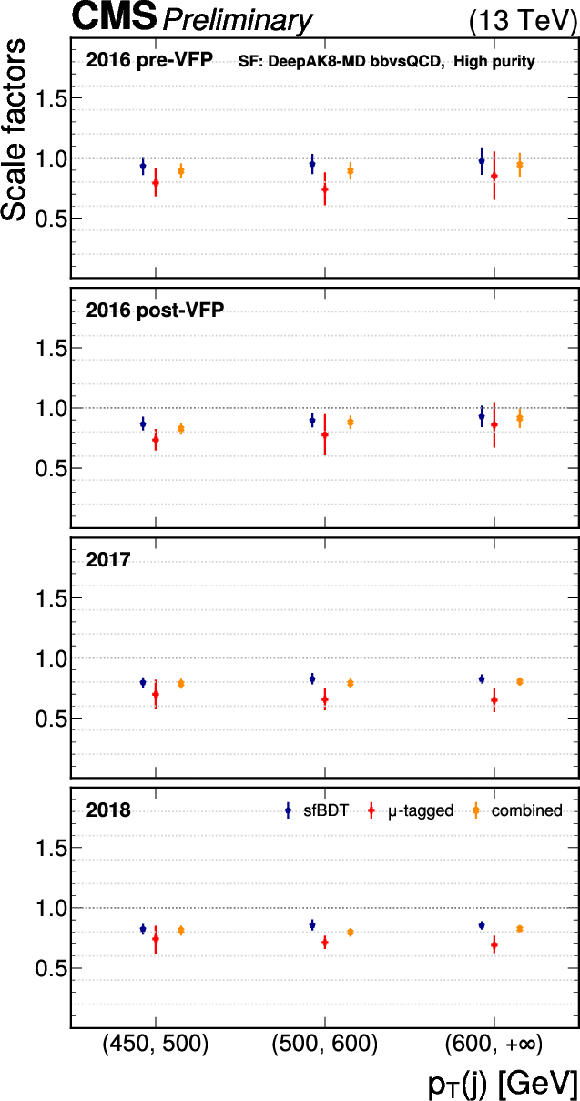
png pdf |
Figure 26-a:
The measured scale factors of the DeepAK8-MD $ \mathrm{X} \rightarrow \mathrm{b} \overline{\mathrm{b}} $ discriminant in the high purity (left), medium purity (middle), and low purity (right) working points. Two methods are presented in the measurements: the sfBDT method and the $ \mu $-tagged method. The combined measurements from available methods are also shown. |

png pdf |
Figure 26-b:
The measured scale factors of the DeepAK8-MD $ \mathrm{X} \rightarrow \mathrm{b} \overline{\mathrm{b}} $ discriminant in the high purity (left), medium purity (middle), and low purity (right) working points. Two methods are presented in the measurements: the sfBDT method and the $ \mu $-tagged method. The combined measurements from available methods are also shown. |
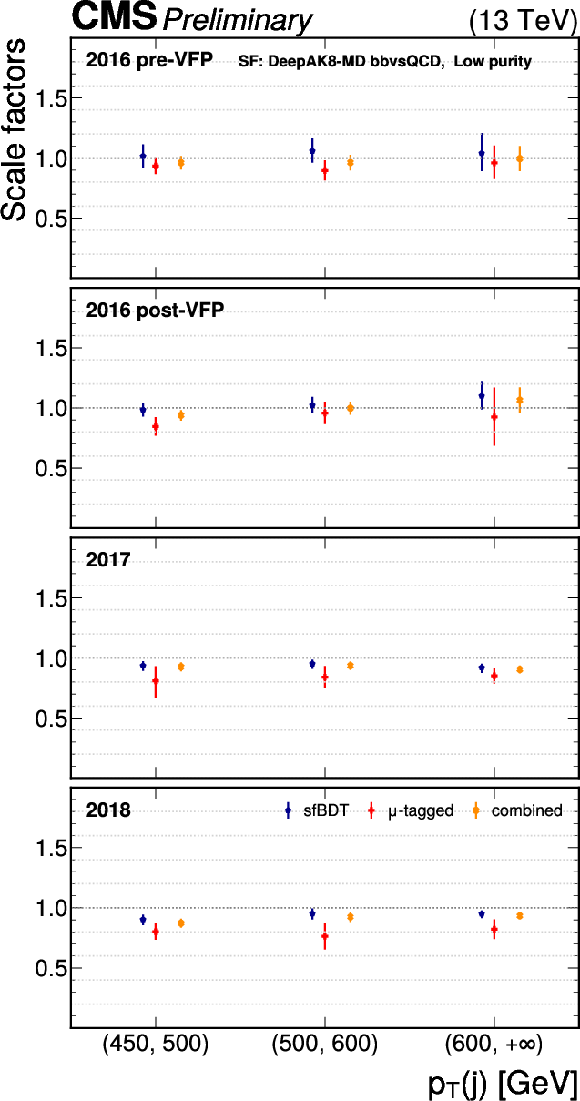
png pdf |
Figure 26-c:
The measured scale factors of the DeepAK8-MD $ \mathrm{X} \rightarrow \mathrm{b} \overline{\mathrm{b}} $ discriminant in the high purity (left), medium purity (middle), and low purity (right) working points. Two methods are presented in the measurements: the sfBDT method and the $ \mu $-tagged method. The combined measurements from available methods are also shown. |

png pdf |
Figure 27:
The measured scale factors of the double-b $ \mathrm{X} \rightarrow \mathrm{b} \overline{\mathrm{b}} $ discriminant in the high purity (left), medium purity (middle), and low purity (right) working points. Three methods are presented in the measurements: the sfBDT method, the $ \mu $-tagged method, and the boosted Z method. The combined measurements from available methods are also shown. |

png pdf |
Figure 27-a:
The measured scale factors of the double-b $ \mathrm{X} \rightarrow \mathrm{b} \overline{\mathrm{b}} $ discriminant in the high purity (left), medium purity (middle), and low purity (right) working points. Three methods are presented in the measurements: the sfBDT method, the $ \mu $-tagged method, and the boosted Z method. The combined measurements from available methods are also shown. |
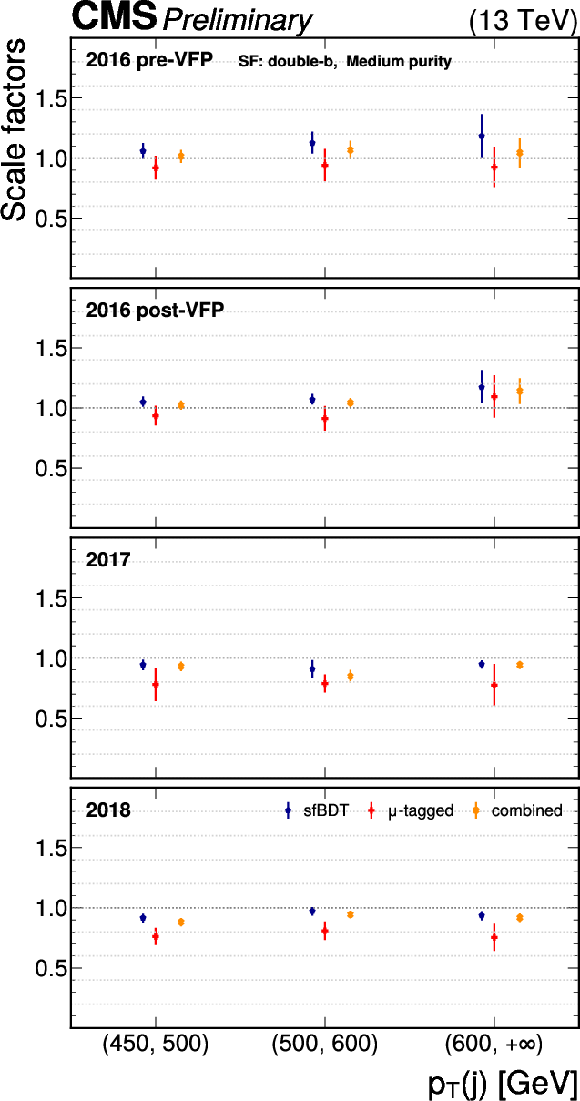
png pdf |
Figure 27-b:
The measured scale factors of the double-b $ \mathrm{X} \rightarrow \mathrm{b} \overline{\mathrm{b}} $ discriminant in the high purity (left), medium purity (middle), and low purity (right) working points. Three methods are presented in the measurements: the sfBDT method, the $ \mu $-tagged method, and the boosted Z method. The combined measurements from available methods are also shown. |
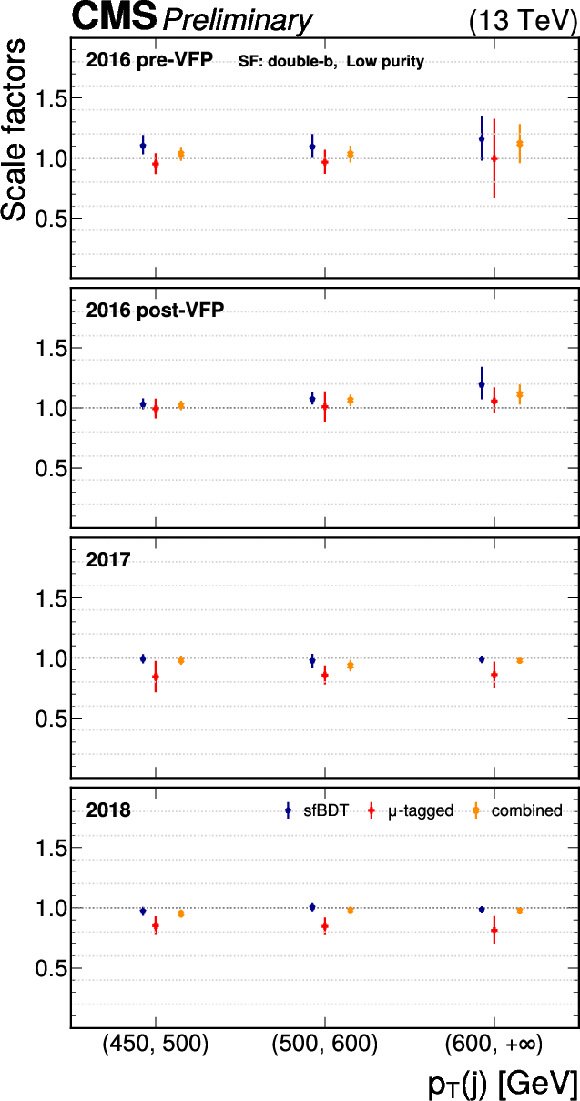
png pdf |
Figure 27-c:
The measured scale factors of the double-b $ \mathrm{X} \rightarrow \mathrm{b} \overline{\mathrm{b}} $ discriminant in the high purity (left), medium purity (middle), and low purity (right) working points. Three methods are presented in the measurements: the sfBDT method, the $ \mu $-tagged method, and the boosted Z method. The combined measurements from available methods are also shown. |

png pdf |
Figure 28:
The measured scale factors of the ParticleNet-MD $ \mathrm{X} \rightarrow \mathrm{c} \overline{\mathrm{c}} $ discriminant in the high purity (left), medium purity (middle), and low purity (right) working points. Two methods are presented in the measurements: the sfBDT method and the $ \mu $-tagged method. The combined measurements from available methods are also shown. |

png pdf |
Figure 28-a:
The measured scale factors of the ParticleNet-MD $ \mathrm{X} \rightarrow \mathrm{c} \overline{\mathrm{c}} $ discriminant in the high purity (left), medium purity (middle), and low purity (right) working points. Two methods are presented in the measurements: the sfBDT method and the $ \mu $-tagged method. The combined measurements from available methods are also shown. |

png pdf |
Figure 28-b:
The measured scale factors of the ParticleNet-MD $ \mathrm{X} \rightarrow \mathrm{c} \overline{\mathrm{c}} $ discriminant in the high purity (left), medium purity (middle), and low purity (right) working points. Two methods are presented in the measurements: the sfBDT method and the $ \mu $-tagged method. The combined measurements from available methods are also shown. |

png pdf |
Figure 28-c:
The measured scale factors of the ParticleNet-MD $ \mathrm{X} \rightarrow \mathrm{c} \overline{\mathrm{c}} $ discriminant in the high purity (left), medium purity (middle), and low purity (right) working points. Two methods are presented in the measurements: the sfBDT method and the $ \mu $-tagged method. The combined measurements from available methods are also shown. |

png pdf |
Figure 29:
The measured scale factors of the DeepDoubleX $ \mathrm{X} \rightarrow \mathrm{c} \overline{\mathrm{c}} $ discriminant in the high purity (left), medium purity (middle), and low purity (right) working points. Two methods are presented in the measurements: the sfBDT method and the $ \mu $-tagged method. The combined measurements from available methods are also shown. |

png pdf |
Figure 29-a:
The measured scale factors of the DeepDoubleX $ \mathrm{X} \rightarrow \mathrm{c} \overline{\mathrm{c}} $ discriminant in the high purity (left), medium purity (middle), and low purity (right) working points. Two methods are presented in the measurements: the sfBDT method and the $ \mu $-tagged method. The combined measurements from available methods are also shown. |

png pdf |
Figure 29-b:
The measured scale factors of the DeepDoubleX $ \mathrm{X} \rightarrow \mathrm{c} \overline{\mathrm{c}} $ discriminant in the high purity (left), medium purity (middle), and low purity (right) working points. Two methods are presented in the measurements: the sfBDT method and the $ \mu $-tagged method. The combined measurements from available methods are also shown. |
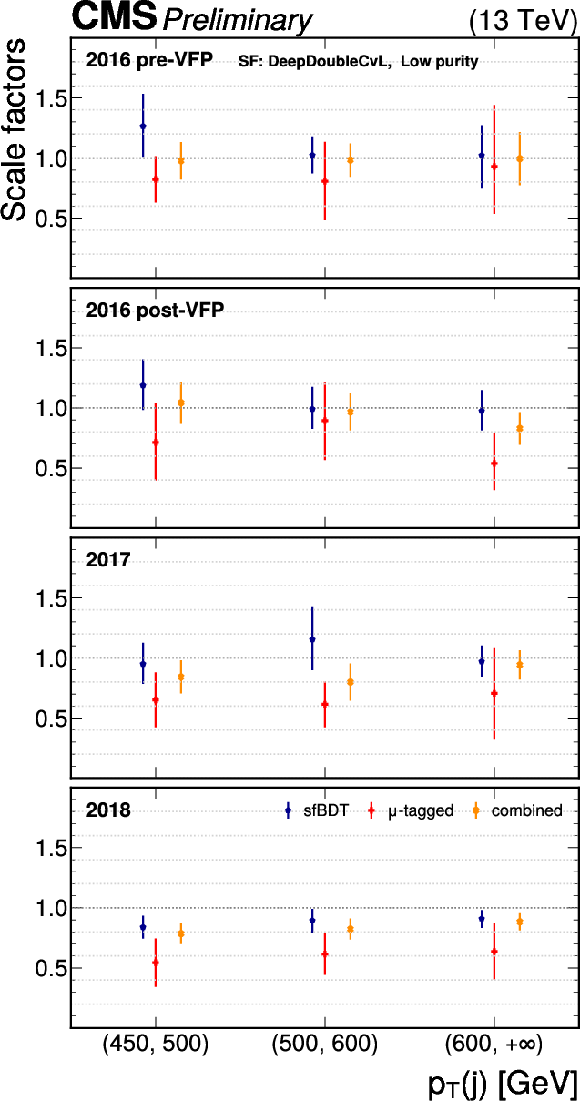
png pdf |
Figure 29-c:
The measured scale factors of the DeepDoubleX $ \mathrm{X} \rightarrow \mathrm{c} \overline{\mathrm{c}} $ discriminant in the high purity (left), medium purity (middle), and low purity (right) working points. Two methods are presented in the measurements: the sfBDT method and the $ \mu $-tagged method. The combined measurements from available methods are also shown. |

png pdf |
Figure 30:
The measured scale factors of the DeepAK8-MD $ \mathrm{X} \rightarrow \mathrm{c} \overline{\mathrm{c}} $ discriminant in the high purity (left), medium purity (middle), and low purity (right) working points. Two methods are presented in the measurements: the sfBDT method and the $ \mu $-tagged method. The combined measurements from available methods are also shown. |

png pdf |
Figure 30-a:
The measured scale factors of the DeepAK8-MD $ \mathrm{X} \rightarrow \mathrm{c} \overline{\mathrm{c}} $ discriminant in the high purity (left), medium purity (middle), and low purity (right) working points. Two methods are presented in the measurements: the sfBDT method and the $ \mu $-tagged method. The combined measurements from available methods are also shown. |

png pdf |
Figure 30-b:
The measured scale factors of the DeepAK8-MD $ \mathrm{X} \rightarrow \mathrm{c} \overline{\mathrm{c}} $ discriminant in the high purity (left), medium purity (middle), and low purity (right) working points. Two methods are presented in the measurements: the sfBDT method and the $ \mu $-tagged method. The combined measurements from available methods are also shown. |

png pdf |
Figure 30-c:
The measured scale factors of the DeepAK8-MD $ \mathrm{X} \rightarrow \mathrm{c} \overline{\mathrm{c}} $ discriminant in the high purity (left), medium purity (middle), and low purity (right) working points. Two methods are presented in the measurements: the sfBDT method and the $ \mu $-tagged method. The combined measurements from available methods are also shown. |

png pdf |
Figure 31:
The data and simulated distributions of the sfBDT discriminant in the 2018 data-taking conditions. The figures correspond to the jet $ p_{\mathrm{T}} $ range of (400, 500) GeV (left) and $ (600,\,+\infty)\,\text{Ge\hspace{-.08em}V} $ (right). |

png pdf |
Figure 31-a:
The data and simulated distributions of the sfBDT discriminant in the 2018 data-taking conditions. The figures correspond to the jet $ p_{\mathrm{T}} $ range of (400, 500) GeV (left) and $ (600,\,+\infty)\,\text{Ge\hspace{-.08em}V} $ (right). |
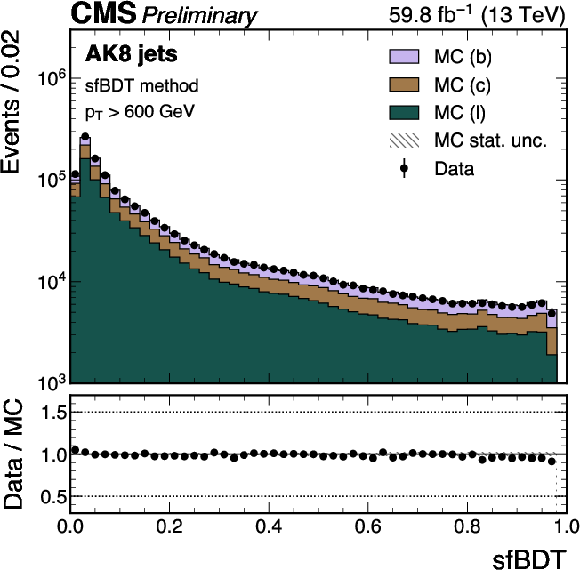
png pdf |
Figure 31-b:
The data and simulated distributions of the sfBDT discriminant in the 2018 data-taking conditions. The figures correspond to the jet $ p_{\mathrm{T}} $ range of (400, 500) GeV (left) and $ (600,\,+\infty)\,\text{Ge\hspace{-.08em}V} $ (right). |
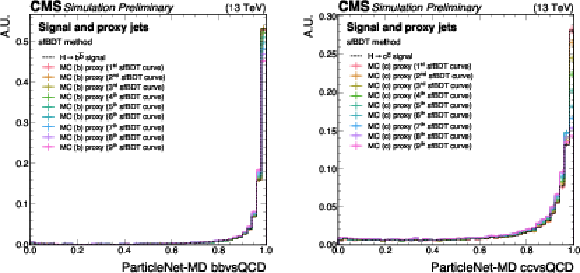
png pdf |
Figure 32:
The normalised distribution of the tagger discriminant for the $ \mathrm{H} \rightarrow \mathrm{b} \overline{\mathrm{b}} $ ($ \mathrm{c} \overline{\mathrm{c}} $) signal jets and the proxy jets selected by different levels of sfBDT selection curves, in the derivation of the scale factor of the ParticleNet-MD $ \mathrm{X} \rightarrow \mathrm{b} \overline{\mathrm{b}} $ (left) and $ \mathrm{X} \rightarrow \mathrm{c} \overline{\mathrm{c}} $ (right) discriminants. The events are simulated in the 2018 data-taking conditions. The same sfBDT selection curve, ranging from the 1\textsuperscriptst (the tightest) to the 9\textsuperscriptth (the loosest) curve, is adopted in the ``pass'' and ``fail'' regions in these plots. The residual discrepancy in the distributions of the signal jets and proxy jets selected by a looser sfBDT curve results from the edge effect in the large values of the tagger discriminant score. |

png pdf |
Figure 32-a:
The normalised distribution of the tagger discriminant for the $ \mathrm{H} \rightarrow \mathrm{b} \overline{\mathrm{b}} $ ($ \mathrm{c} \overline{\mathrm{c}} $) signal jets and the proxy jets selected by different levels of sfBDT selection curves, in the derivation of the scale factor of the ParticleNet-MD $ \mathrm{X} \rightarrow \mathrm{b} \overline{\mathrm{b}} $ (left) and $ \mathrm{X} \rightarrow \mathrm{c} \overline{\mathrm{c}} $ (right) discriminants. The events are simulated in the 2018 data-taking conditions. The same sfBDT selection curve, ranging from the 1\textsuperscriptst (the tightest) to the 9\textsuperscriptth (the loosest) curve, is adopted in the ``pass'' and ``fail'' regions in these plots. The residual discrepancy in the distributions of the signal jets and proxy jets selected by a looser sfBDT curve results from the edge effect in the large values of the tagger discriminant score. |
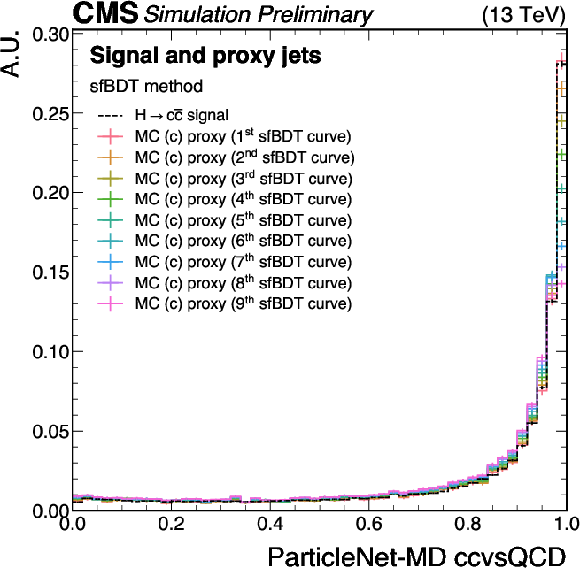
png pdf |
Figure 32-b:
The normalised distribution of the tagger discriminant for the $ \mathrm{H} \rightarrow \mathrm{b} \overline{\mathrm{b}} $ ($ \mathrm{c} \overline{\mathrm{c}} $) signal jets and the proxy jets selected by different levels of sfBDT selection curves, in the derivation of the scale factor of the ParticleNet-MD $ \mathrm{X} \rightarrow \mathrm{b} \overline{\mathrm{b}} $ (left) and $ \mathrm{X} \rightarrow \mathrm{c} \overline{\mathrm{c}} $ (right) discriminants. The events are simulated in the 2018 data-taking conditions. The same sfBDT selection curve, ranging from the 1\textsuperscriptst (the tightest) to the 9\textsuperscriptth (the loosest) curve, is adopted in the ``pass'' and ``fail'' regions in these plots. The residual discrepancy in the distributions of the signal jets and proxy jets selected by a looser sfBDT curve results from the edge effect in the large values of the tagger discriminant score. |
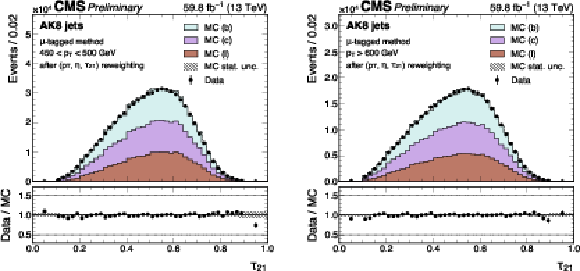
png pdf |
Figure 33:
The data and simulated distribution of the $ N $-subjettiness $ \tau_{21} $ variable in the 2018 data-taking conditions. The simulated distribution is obtained after performing a jet-based reweighting on the binned histogram of $ (p_{\mathrm{T}}, \eta, \tau_{21}) $ from QCD multijet events to data, where the latter is subtracted by the simulated $ \mathrm{t} \overline{\mathrm{t}} $, single top quark and V+jets contributions. The figures correspond to the jet $ p_{\mathrm{T}} $ range of (400, 500) GeV (left) and $ (600,\,+\infty)\,\text{Ge\hspace{-.08em}V} $ (right). |

png pdf |
Figure 33-a:
The data and simulated distribution of the $ N $-subjettiness $ \tau_{21} $ variable in the 2018 data-taking conditions. The simulated distribution is obtained after performing a jet-based reweighting on the binned histogram of $ (p_{\mathrm{T}}, \eta, \tau_{21}) $ from QCD multijet events to data, where the latter is subtracted by the simulated $ \mathrm{t} \overline{\mathrm{t}} $, single top quark and V+jets contributions. The figures correspond to the jet $ p_{\mathrm{T}} $ range of (400, 500) GeV (left) and $ (600,\,+\infty)\,\text{Ge\hspace{-.08em}V} $ (right). |

png pdf |
Figure 33-b:
The data and simulated distribution of the $ N $-subjettiness $ \tau_{21} $ variable in the 2018 data-taking conditions. The simulated distribution is obtained after performing a jet-based reweighting on the binned histogram of $ (p_{\mathrm{T}}, \eta, \tau_{21}) $ from QCD multijet events to data, where the latter is subtracted by the simulated $ \mathrm{t} \overline{\mathrm{t}} $, single top quark and V+jets contributions. The figures correspond to the jet $ p_{\mathrm{T}} $ range of (400, 500) GeV (left) and $ (600,\,+\infty)\,\text{Ge\hspace{-.08em}V} $ (right). |

png pdf |
Figure 34:
The normalised distribution of the tagger discriminant for the $ \mathrm{H} \rightarrow \mathrm{b} \overline{\mathrm{b}} $ ($ \mathrm{c} \overline{\mathrm{c}} $) signal jets and the proxy jets selected by $ \tau_{21} $ at different thresholds, in the derivation of the scale factor of the ParticleNet-MD $ \mathrm{X} \rightarrow \mathrm{b} \overline{\mathrm{b}} $ (left) and $ \mathrm{X} \rightarrow \mathrm{c} \overline{\mathrm{c}} $ (right) discriminants. This example is based on data and simulated events in the 2018 data-taking conditions. |

png pdf |
Figure 34-a:
The normalised distribution of the tagger discriminant for the $ \mathrm{H} \rightarrow \mathrm{b} \overline{\mathrm{b}} $ ($ \mathrm{c} \overline{\mathrm{c}} $) signal jets and the proxy jets selected by $ \tau_{21} $ at different thresholds, in the derivation of the scale factor of the ParticleNet-MD $ \mathrm{X} \rightarrow \mathrm{b} \overline{\mathrm{b}} $ (left) and $ \mathrm{X} \rightarrow \mathrm{c} \overline{\mathrm{c}} $ (right) discriminants. This example is based on data and simulated events in the 2018 data-taking conditions. |

png pdf |
Figure 34-b:
The normalised distribution of the tagger discriminant for the $ \mathrm{H} \rightarrow \mathrm{b} \overline{\mathrm{b}} $ ($ \mathrm{c} \overline{\mathrm{c}} $) signal jets and the proxy jets selected by $ \tau_{21} $ at different thresholds, in the derivation of the scale factor of the ParticleNet-MD $ \mathrm{X} \rightarrow \mathrm{b} \overline{\mathrm{b}} $ (left) and $ \mathrm{X} \rightarrow \mathrm{c} \overline{\mathrm{c}} $ (right) discriminants. This example is based on data and simulated events in the 2018 data-taking conditions. |
| Tables | |
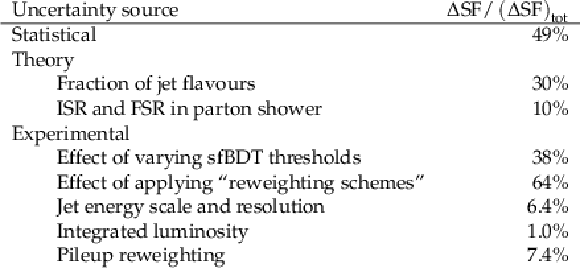
png pdf |
Table 1:
The relative contributions to the total uncertainty in the fitted scale factor (SF) of the ParticleNet-MD $ \mathrm{X} \rightarrow \mathrm{b} \overline{\mathrm{b}} $ discriminant at the high purity working point, using the sfBDT method. The numbers are averaged over multiple SF derivation points, including all relevant $ p_{\mathrm{T}} $ bins and data-taking eras. |

png pdf |
Table 2:
The relative contributions to the total uncertainty in the fitted scale factor (SF) of the ParticleNet-MD $ \mathrm{X} \rightarrow \mathrm{b} \overline{\mathrm{b}} $ discriminant at the high purity working point, using the $ \mu $-tagged method. The numbers are averaged over multiple SF derivation points, including all relevant $ p_{\mathrm{T}} $ bins and data-taking eras. |

png pdf |
Table 3:
The relative contributions to the total uncertainty in the fitted scale factor (SF) of the ParticleNet-MD $ \mathrm{X} \rightarrow \mathrm{b} \overline{\mathrm{b}} $ discriminant at the high purity working point, using the boosted Z method. The numbers are averaged over multiple SF derivation points, including all relevant $ p_{\mathrm{T}} $ bins and data-taking eras. |
| Summary |
| The performance of the heavy-flavour $ \mathrm{X} \rightarrow \mathrm{b} \overline{\mathrm{b}} $ and $ \mathrm{X} \rightarrow \mathrm{c} \overline{\mathrm{c}} $ jet tagging algorithms in the boosted topology on data collected by the CMS detector during the 2016--2018 data-taking period (Run 2) is presented. As the boosted topology has gained more interest for physics searches during Run 2, dedicated techniques for jet tagging and methods for calibrating the taggers on data have become increasingly important. In this note, we first provide a complete review and a comparison of $ \mathrm{X} \rightarrow \mathrm{b} \overline{\mathrm{b}} $ and $ \mathrm{X} \rightarrow \mathrm{c} \overline{\mathrm{c}} $ tagging algorithms, which are developed by the CMS Collaboration during Run 2 and have been used for various physics measurements. These algorithms include the ParticleNet-MD, DeepDoubleX, DeepAK8, and the double-b algorithms. Three methods for evaluating the performance of the algorithms on data, in terms of deriving the scale factors to correct the simulated $ \mathrm{X} \rightarrow \mathrm{b} \overline{\mathrm{b}} $ and $ \mathrm{X} \rightarrow \mathrm{c} \overline{\mathrm{c}} $ jets, are presented in detail. The three methods define the proxy jet from (1) the novel phase space selected from gluon-splitting $ \mathrm{b} \overline{\mathrm{b}} $ and $ \mathrm{c} \overline{\mathrm{c}} $ jets via a dedicated boost decision tree (BDT); (2) the gluon-splitting $ \mathrm{b} \overline{\mathrm{b}} $ and $ \mathrm{c} \overline{\mathrm{c}} $ jets containing a soft muon, with an auxiliary selection on the $ N $-subjettiness variable; and (3) the boosted $ \mathrm{Z} \rightarrow \mathrm{b} \overline{\mathrm{b}} $ jets for representing the $ \mathrm{X} \rightarrow \mathrm{b} \overline{\mathrm{b}} $ signal jet. The phase space of the selected proxy jets from data is largely orthogonal, which enables cross-checking between the methods. The resulting scale factors, derived for all working points of seven studied tagging discriminants for $ \mathrm{X} \rightarrow \mathrm{b} \overline{\mathrm{b}} $ and $ \mathrm{X} \rightarrow \mathrm{c} \overline{\mathrm{c}} $ tagging, are presented. The scale factors are showcased individually as well as after combining them with the best linear unbiased estimator method. A reasonable agreement is found when comparing the results with previous CMS studies, which calibrated some of the discriminants studied in this work, either partially or under full Run 2 conditions. The tagging algorithms and calibration approaches documented in this note serve as a comprehensive summary and are considered as benchmarks for the techniques adopted by the CMS Collaboration during Run 2. These outcomes will facilitate further in-depth studies and wider experimental explorations of the boosted phase space with heavy-flavour tagging in the future. |
| References | ||||
| 1 | CMS Collaboration | Identification of heavy-flavour jets with the CMS detector in pp collisions at 13 TeV | JINST 13 (2018) P05011 | CMS-BTV-16-002 1712.07158 |
| 2 | ATLAS Collaboration | Identification of boosted Higgs bosons decaying into $ b $-quark pairs with the ATLAS detector at 13 $ \text {TeV} $ | EPJC 79 (2019) 836 | 1906.11005 |
| 3 | ATLAS Collaboration | Identification of Boosted Higgs Bosons Decaying Into $ b\bar{b} $ With Neural Networks and Variable Radius Subjets in ATLAS | ATLAS PUB Note ATL-PHYS-PUB-2020-019, 2020 | |
| 4 | CMS Collaboration | Identification of heavy, energetic, hadronically decaying particles using machine-learning techniques | JINST 15 (2020) P06005 | CMS-JME-18-002 2004.08262 |
| 5 | ATLAS Collaboration | Identification of hadronically-decaying top quarks using UFO jets with ATLAS in Run 2 | ATLAS PUB Note ATL-PHYS-PUB-2021-028, 2021 | |
| 6 | ATLAS Collaboration | Performance of $ W $/$ Z $ taggers using UFO jets in ATLAS | ATLAS PUB Note ATL-PHYS-PUB-2021-029, 2021 | |
| 7 | CMS Collaboration | Identification of highly Lorentz-boosted heavy particles using graph neural networks and new mass decorrelation techniques | CMS Detector Performance Summary CMS-DP-2020-002, 2020 CDS |
|
| 8 | CMS Collaboration | Performance of the mass-decorrelated DeepDoubleX classifier for double-b and double-c large-radius jets with the CMS detector | CMS Detector Performance Summary CMS-DP-2022-041, 2022 CDS |
|
| 9 | CMS Collaboration | Inclusive search for a highly boosted Higgs boson decaying to a bottom quark-antiquark pair | PRL 120 (2018) 071802 | CMS-HIG-17-010 1709.05543 |
| 10 | CMS Collaboration | Inclusive search for highly boosted Higgs bosons decaying to bottom quark-antiquark pairs in proton-proton collisions at $ \sqrt{s} = $ 13 TeV | JHEP 12 (2020) 085 | CMS-HIG-19-003 2006.13251 |
| 11 | CMS Collaboration | Search for resonant Higgs boson pair production in four b quark final state using large-area jets in proton-proton collisions at $ \sqrt{s} = $ 13 TeV | CMS Physics Analysis Summary CMS-PAS-B2G-20-004, 2021 CDS |
|
| 12 | CMS Collaboration | Search for nonresonant pair production of highly energetic Higgs bosons decaying to bottom quarks | accepted by Phys. Rev. Lett | 2205.06667 |
| 13 | CMS Collaboration | A search for the standard model Higgs boson decaying to charm quarks | JHEP 03 (2020) 131 | CMS-HIG-18-031 1912.01662 |
| 14 | CMS Collaboration | Search for Higgs boson decay to a charm quark-antiquark pair in proton-proton collisions at $ \sqrt{s} $ = 13 TeV | accepted by Phys. Rev. Lett | CMS-HIG-21-008 2205.05550 |
| 15 | CMS Collaboration | Search for boosted Higgs boson decay to a charm quark-antiquark pair in proton-proton collisions at $ \sqrt{s} $ = 13 TeV | accepted by Phys. Rev. Lett | CMS-HIG-21-012 2211.14181 |
| 16 | CMS Collaboration | Search for a massive scalar resonance decaying to a light scalar and a Higgs boson in the four b quarks final state with boosted topology | (4, ), 2022 PLB 1 (2022) 9 |
2204.12413 |
| 17 | CMS Collaboration | The CMS experiment at the CERN LHC | JINST 3 (2008) S08004 | |
| 18 | CMS Collaboration | The CMS trigger system | JINST 12 (2017) P01020 | CMS-TRG-12-001 1609.02366 |
| 19 | CMS Collaboration | Performance of the CMS Level-1 trigger in proton-proton collisions at $ \sqrt{s} = $ 13 TeV | JINST 15 (2020) P10017 | CMS-TRG-17-001 2006.10165 |
| 20 | J. Alwall et al. | The automated computation of tree-level and next-to-leading order differential cross sections, and their matching to parton shower simulations | JHEP 07 (2014) 079 | 1405.0301 |
| 21 | P. Nason | A new method for combining NLO QCD with shower Monte Carlo algorithms | JHEP 11 (2004) 040 | hep-ph/0409146 |
| 22 | S. Frixione, P. Nason, and C. Oleari | Matching NLO QCD computations with parton shower simulations: the POWHEG method | JHEP 11 (2007) 070 | 0709.2092 |
| 23 | S. Alioli, P. Nason, C. Oleari, and E. Re | A general framework for implementing NLO calculations in shower Monte Carlo programs: the POWHEG BOX | JHEP 06 (2010) 043 | 1002.2581 |
| 24 | J. M. Campbell, R. K. Ellis, P. Nason, and E. Re | Top-pair production and decay at NLO matched with parton showers | JHEP 04 (2015) 114 | 1412.1828 |
| 25 | M. Czakon and A. Mitov | Top++: A program for the calculation of the top-pair cross-section at hadron colliders | Comput. Phys. Commun. 185 (2014) 2930 | 1112.5675 |
| 26 | R. Frederix, E. Re, and P. Torrielli | Single-top $ t $-channel hadroproduction in the four-flavour scheme with POWHEG and aMC@NLO | JHEP 09 (2012) 130 | 1207.5391 |
| 27 | S. Alioli, P. Nason, C. Oleari, and E. Re | NLO single-top production matched with shower in POWHEG: $ s $- and $ t $-channel contributions | JHEP 09 (2009) 111 | 0907.4076 |
| 28 | S. Frixione et al. | Single-top hadroproduction in association with a W boson | JHEP 07 (2008) 029 | 0805.3067 |
| 29 | E. Re | Single-top Wt-channel production matched with parton showers using the POWHEG method | EPJC 71 (2011) 1547 | 1009.2450 |
| 30 | N. Kidonakis | NNLL threshold resummation for top-pair and single-top production | Phys. Part. Nucl. 45 (2014) 714 | 1210.7813 |
| 31 | T. Sjöstrand et al. | An introduction to PYTHIA 8.2 | Comput. Phys. Commun. 191 (2015) 159 | 1410.3012 |
| 32 | CMS Collaboration | Extraction and validation of a new set of CMS PYTHIA8 tunes from underlying-event measurements | EPJC 80 (2020) 4 | CMS-GEN-17-001 1903.12179 |
| 33 | NNPDF Collaboration | Parton distributions from high-precision collider data | EPJC 77 (2017) 663 | 1706.00428 |
| 34 | J. Alwall et al. | Comparative study of various algorithms for the merging of parton showers and matrix elements in hadronic collisions | EPJC 53 (2008) 473 | 0706.2569 |
| 35 | R. Frederix and S. Frixione | Merging meets matching in MC@NLO | JHEP 12 (2012) 061 | 1209.6215 |
| 36 | J. M. Lindert et al. | Precise predictions for V+jets dark matter backgrounds | EPJC 77 (2017) 829 | 1705.04664 |
| 37 | K. Hamilton, P. Nason, C. Oleari, and G. Zanderighi | Merging H/W/Z + 0 and 1 jet at NLO with no merging scale: a path to parton shower + NNLO matching | JHEP 05 (2013) 082 | 1212.4504 |
| 38 | G. Luisoni, P. Nason, C. Oleari, and F. Tramontano | $ \mathrm{H}\mathrm{W}^{\pm} $/HZ+0 and 1 jet at NLO with the POWHEG box interfaced to GoSam and their merging within MINLO | JHEP 10 (2013) 083 | 1306.2542 |
| 39 | GEANT4 Collaboration | GEANT4---a simulation toolkit | NIM A 506 (2003) 250 | |
| 40 | CMS Collaboration | Simulation of the Silicon Strip Tracker pre-amplifier in early 2016 data | CMS Detector Performance Summary CMS-DP-2020-045, 2020 CDS |
|
| 41 | CMS Collaboration | Particle-flow reconstruction and global event description with the CMS detector | JINST 12 (2017) P10003 | CMS-PRF-14-001 1706.04965 |
| 42 | CMS Collaboration | Technical proposal for the Phase-II upgrade of the Compact Muon Solenoid | CMS Technical Proposal CERN-LHCC-2015-010, CMS-TDR-15-02, 2015 CDS |
|
| 43 | CMS Collaboration | Measurement of $ {\text{B}}\overline{\text{B}} $ angular correlations based on secondary vertex reconstruction at $ \sqrt{s}= $ 7 TeV | JHEP 03 (2011) 136 | CMS-BPH-10-010 1102.3194 |
| 44 | M. Cacciari, G. P. Salam, and G. Soyez | The anti-$ k_{\mathrm{T}} $ jet clustering algorithm | JHEP 04 (2008) 063 | 0802.1189 |
| 45 | CMS Collaboration | Jet energy scale and resolution in the CMS experiment in pp collisions at 8 TeV | JINST 12 (2017) P02014 | CMS-JME-13-004 1607.03663 |
| 46 | CMS Collaboration | Pileup mitigation at CMS in 13 TeV data | JINST 15 (2020) P09018 | CMS-JME-18-001 2003.00503 |
| 47 | D. Bertolini, P. Harris, M. Low, and N. Tran | Pileup Per Particle Identification | JHEP 10 (2014) 059 | 1407.6013 |
| 48 | J. Thaler and K. Van Tilburg | Identifying Boosted Objects with N-subjettiness | JHEP 03 (2011) 015 | 1011.2268 |
| 49 | A. J. Larkoski, S. Marzani, G. Soyez, and J. Thaler | Soft Drop | JHEP 05 (2014) 146 | 1402.2657 |
| 50 | CMS Collaboration | Mass regression of highly-boosted jets using graph neural networks | CMS Detector Performance Summary CMS-DP-2021-017, 2021 CDS |
|
| 51 | H. Qu and L. Gouskos | ParticleNet: Jet Tagging via Particle Clouds | no.~5, 056019, 2020 PRD 101 (2020) |
1902.08570 |
| 52 | M. Cacciari and G. P. Salam | Pileup subtraction using jet areas | PLB 659 (2008) 119 | 0707.1378 |
| 53 | CMS Collaboration | Performance of Deep Tagging Algorithms for Boosted Double Quark Jet Topology in Proton-Proton Collisions at 13 TeV with the Phase-0 CMS Detector | CMS Detector Performance Summary CMS-DP-2018-046, 2018 CDS |
|
| 54 | E. Bols et al. | Jet flavour classification using DeepJet | JINST 15 (2020) P12012 | 2008.10519 |
| 55 | K. He, X. Zhang, S. Ren, and J. Sun | Deep residual learning for image recognition | in Proceedings of the IEEE conference on computer vision and pattern recognition, 2016 | |
| 56 | CMS Collaboration | Calibration of the mass-decorrelated ParticleNet tagger for boosted $ \mathrm{b} \overline{\mathrm{b}} $ and $ \mathrm{c} \overline{\mathrm{c}} $ jets using LHC Run 2 data | CMS Detector Performance Summary CMS-DP-2022-005, 2022 CDS |
|
| 57 | S. Catani, Y. L. Dokshitzer, M. H. Seymour, and B. R. Webber | Longitudinally invariant $ K_t $ clustering algorithms for hadron hadron collisions | NPB 406 (1993) 187 | |
| 58 | S. D. Ellis and D. E. Soper | Successive combination jet algorithm for hadron collisions | PRD 48 (1993) 3160 | hep-ph/9305266 |
| 59 | CMS Collaboration | Performance of missing transverse momentum reconstruction in proton-proton collisions at $ \sqrt{s} = $ 13\,TeV using the CMS detector | JINST 14 (2019) P07004 | CMS-JME-17-001 1903.06078 |
| 60 | CMS Collaboration | Precision luminosity measurement in proton-proton collisions at $ \sqrt{s} = $ 13 TeV in 2015 and 2016 at CMS | EPJC 81 (2021) 800 | CMS-LUM-17-003 2104.01927 |
| 61 | CMS Collaboration | CMS luminosity measurement for the 2017 data-taking period at $ \sqrt{s} $ = 13 TeV | CMS Physics Analysis Summary, 2018 link |
CMS-PAS-LUM-17-004 |
| 62 | CMS Collaboration | CMS luminosity measurement for the 2018 data-taking period at $ \sqrt{s} $ = 13 TeV | CMS Physics Analysis Summary, 2019 link |
CMS-PAS-LUM-18-002 |
| 63 | CMS Collaboration | Measurement of the inelastic proton-proton cross section at $ \sqrt{\text{s}}\text{ = 13} $ TeV | JHEP 07 (2018) 161 | CMS-FSQ-15-005 1802.02613 |
| 64 | CMS Collaboration | A new calibration method for charm jet identification validated with proton-proton collision events at $ \sqrt{s} $ =13 TeV | JINST 17 (2022) P03014 | CMS-BTV-20-001 2111.03027 |
| 65 | D. Krohn, J. Thaler, and L.-T. Wang | Jet trimming | JHEP 02 (2010) 084 | 0912.1342 |
| 66 | CMS Collaboration | Electron and photon reconstruction and identification with the CMS experiment at the CERN LHC | JINST 16 (2021) P05014 | CMS-EGM-17-001 2012.06888 |
| 67 | CMS Collaboration | Performance of the CMS muon detector and muon reconstruction with proton-proton collisions at $ \sqrt{s}= $ 13 TeV | JINST 13 (2018) P06015 | CMS-MUO-16-001 1804.04528 |
| 68 | J. Butterworth et al. | PDF4LHC recommendations for LHC Run II | JPG 43 (2016) 023001 | 1510.03865 |
| 69 | L. Lyons, D. Gibaut, and P. Clifford | How to combine correlated estimates of a single physical quantity | NIM A 270 (1988) 110 | |
| 70 | A. Valassi | Combining correlated measurements of several different physical quantities | NIM A 500 (2003) 391 | |

|
Compact Muon Solenoid LHC, CERN |

|

|

|

|

|

|